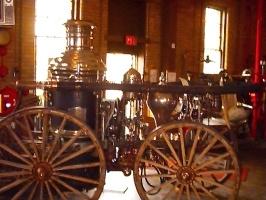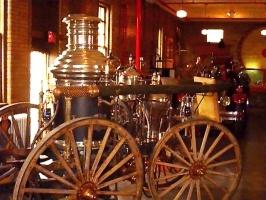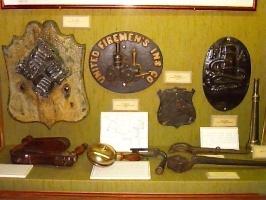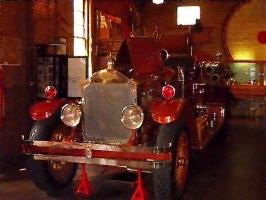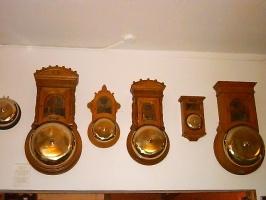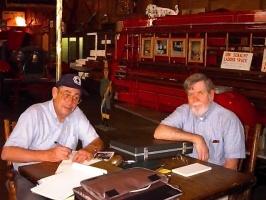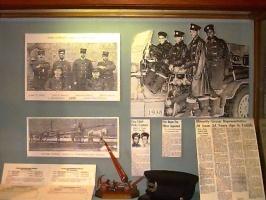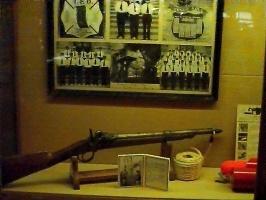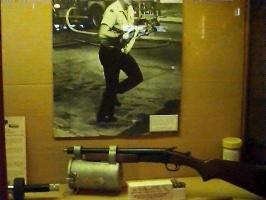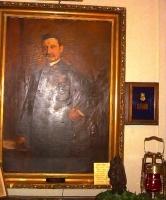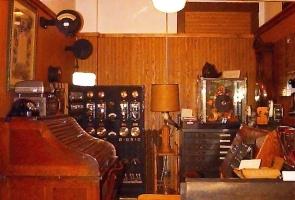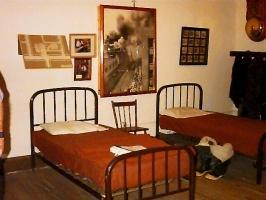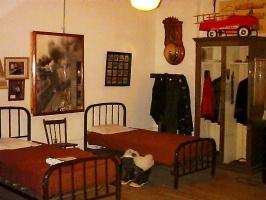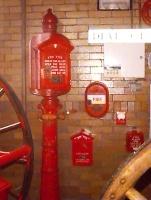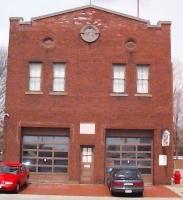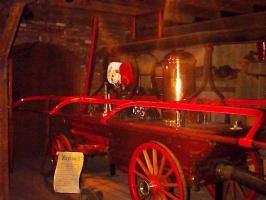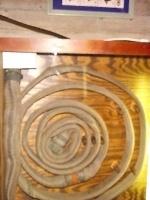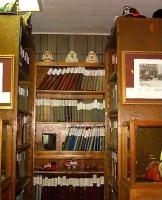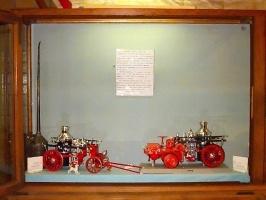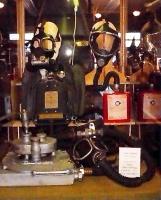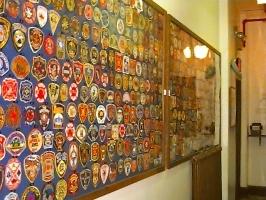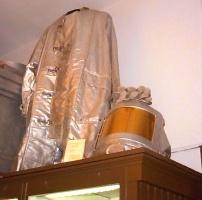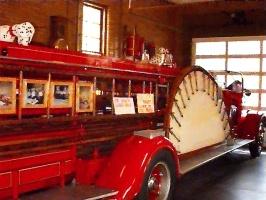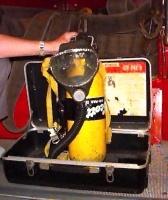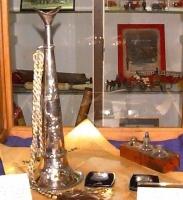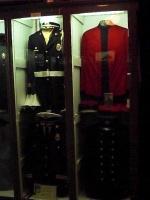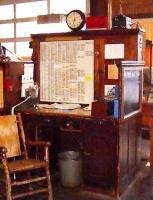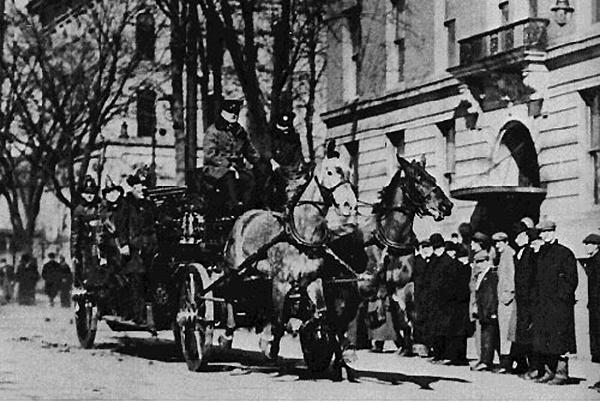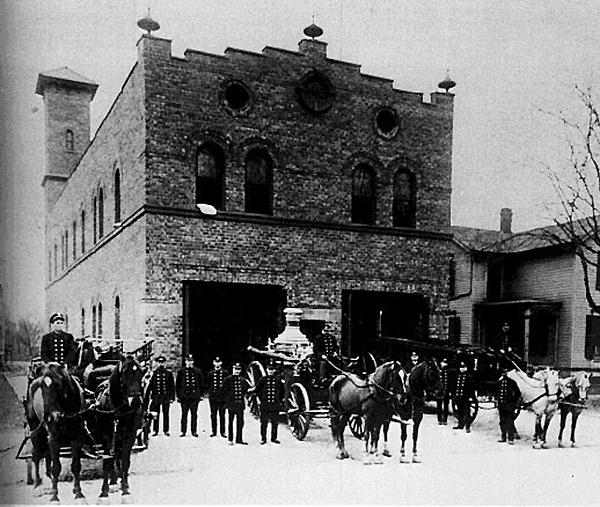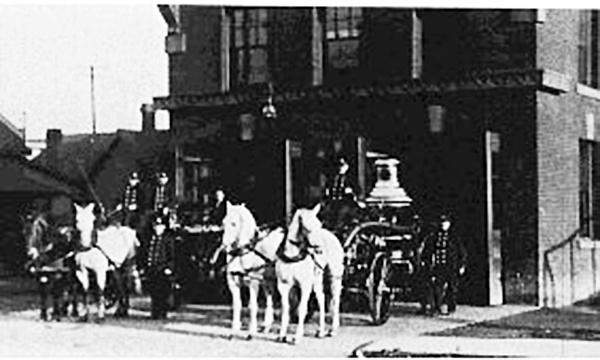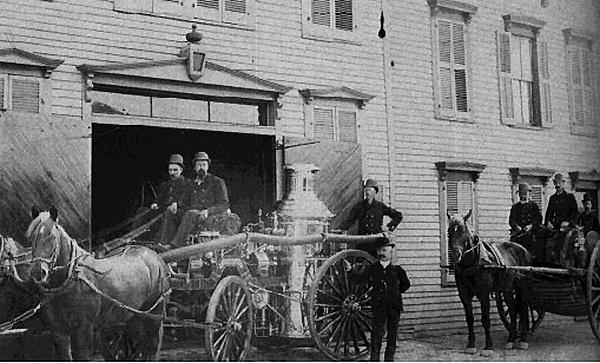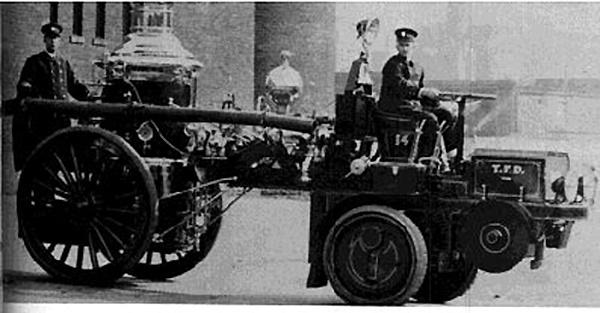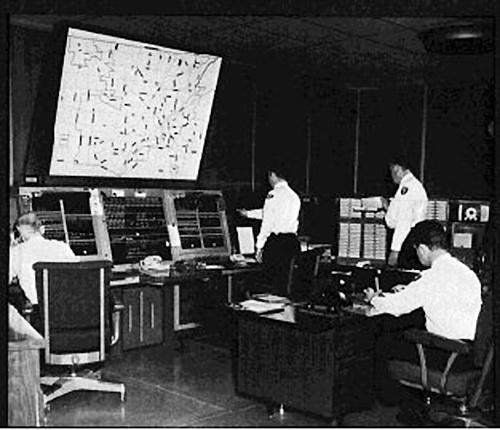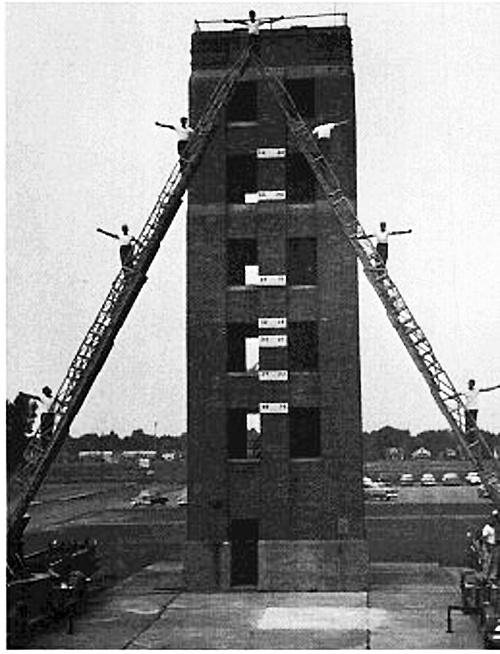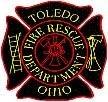 Toledo Fire Rescue Department Patch
Toledo Fire Rescue Department Patch
Exhibit Gallery
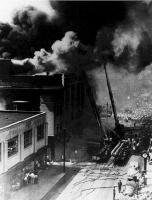
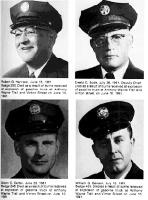
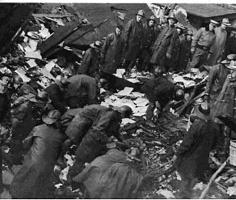
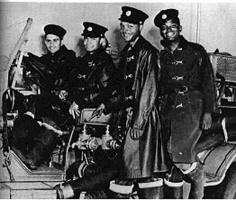
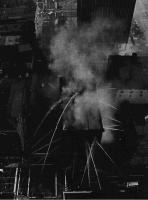
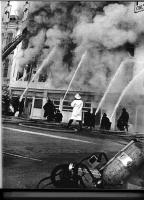
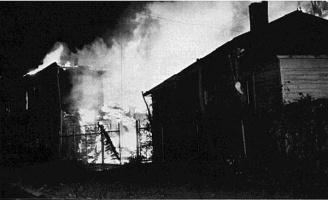
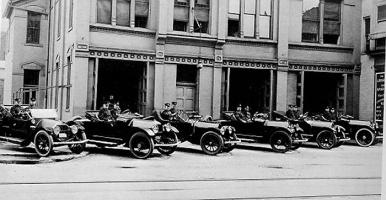
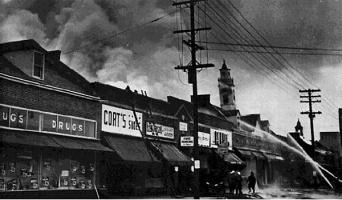
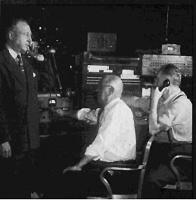
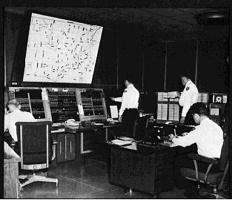
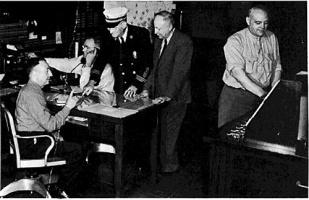
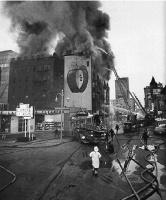
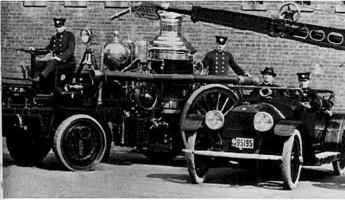
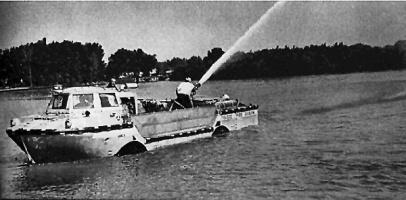
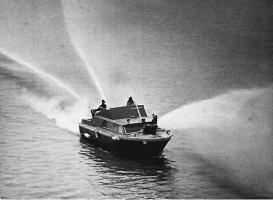
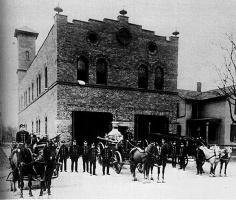
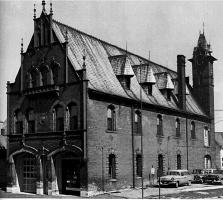
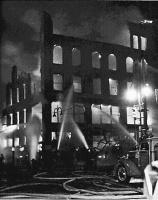
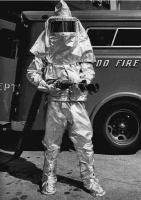
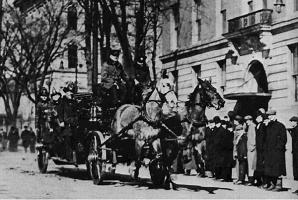
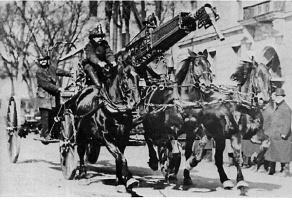

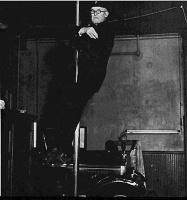
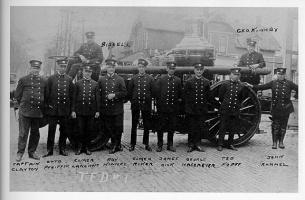
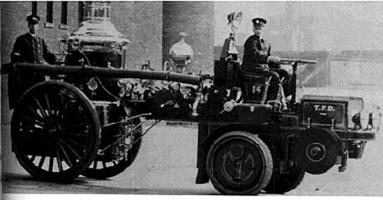
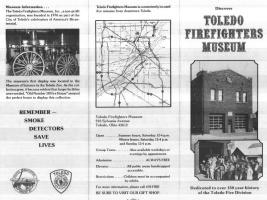
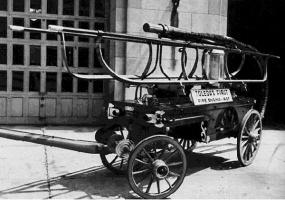
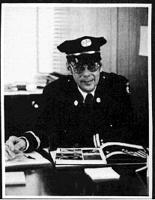
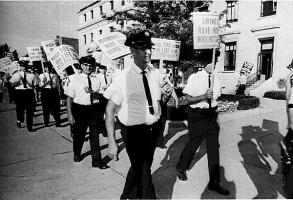
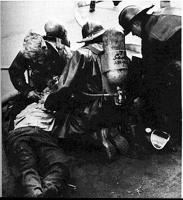
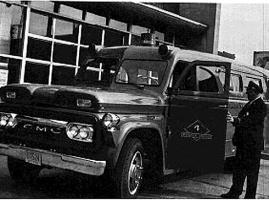
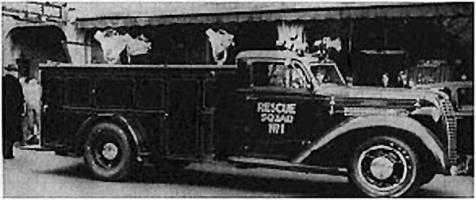
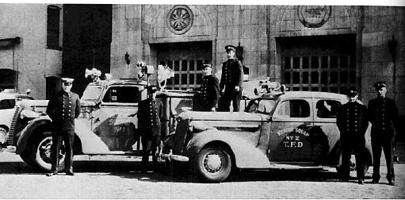
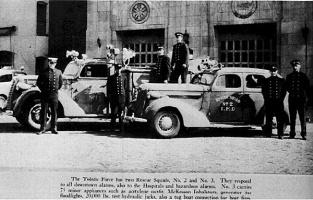
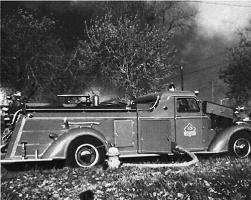
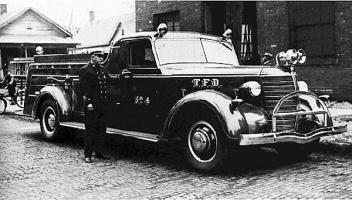
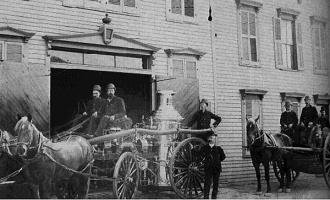
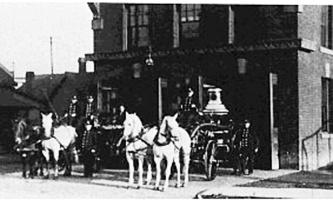
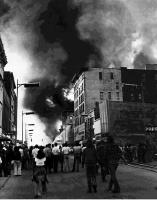
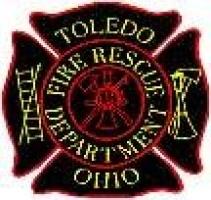
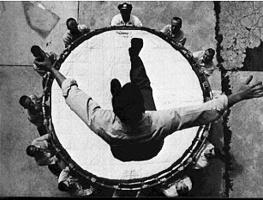
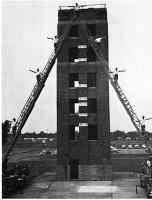
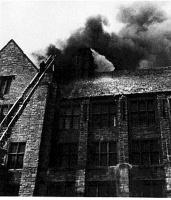
A Century of Fire: Toledo's Firefighting History
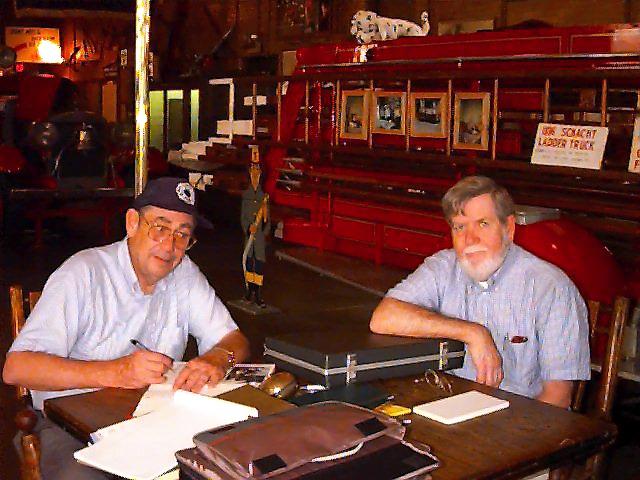 Bill O'Connor and Herb Zieman.
Bill O'Connor and Herb Zieman. Fire Rescue Department Patch
Fire Rescue Department Patch 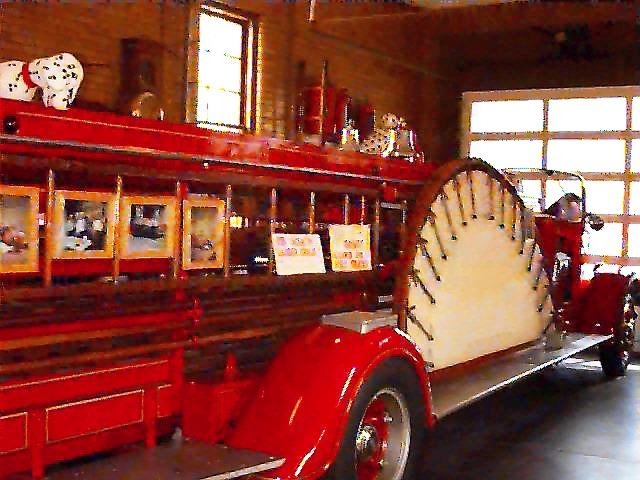 1936 Schacht Ladder Truck
1936 Schacht Ladder Truck
The Toledo Fire Department dates back to 1837. This exhibit explores the rich and colorful history of the fire department, examining the firefighters, their equipment, and the fires that they fought through newspaper articles, remembrances, fire station documents, and photographs.
Acknowledgment: This exhibit would not have been possible without the assistance and scholarship of Capt. William T. O' Connor of the Toledo Firefighters Museum.The Department.
The Early Years, 1837-1873, from History of the Toledo Fire Division, 1837-1977.
The earliest known action taken to form the Toledo Fire Department was on May 29, 1837. At this time, City Council selected a committee to determine the cost of two fire engines for the City of Toledo. On September 25, 1837, the firm of Hoisington and Manning was given the contract to build Engine House No. 1 and the following year to build Engine House No. 2.
In December of 1837, Council appointed the first officers and fire warden of our new department.
In the years following 1837, in mid February or early March, a Fireman’s Convention was held. Each fire company and hook and ladder company would send a certain number of delegates based on the membership of each company, and the delegates would nominate a Chief Engineer, 1st Assistant CE, and 2nd Assistant CE. These nominations were presented to council, who then appointed the officers of the fire department, usually as one of the last acts of an outgoing council. These appointments were for a one-year term. Nomination by the Fireman’s Convention was considered by the firemen as tantamount to appointment by the council. On one occasion when the council failed to appoint the nominated candidates, four fire companies subsequently disbanded in protest. (April 8, 1865)
The roll of a company, when completed, generally consisted of eighty men. Every applicant had to pass inspection for integrity and good character and be voted on by members previously enrolled. He then received a certificate of membership to the Toledo Fire Department; this certificate indicated the number of the company he was enrolled with. The officers of a company, who were usually elected at an annual meeting held during the first week of January, were a Foreman, 1st Asst. Foreman, 2nd Asst. Foreman, Secretary, and Treasurer. In the 1850s, the council provided that the men could elect officers for those who worked the fire engine as well as officers for those who worked the hose carriage. The Foreman of the engine company, however, was to have charge over the men and officers of both the engine and hose companies.
An organization known as the Teutonic Fire Guards No. 1 was formed in February, 1856 to protect the personal property at the scene of a fire.
Sometime after the first high school was built in 1854-5, a man was kept in its tower each night to ring the bell when fire broke out. The number of the ward and district were indicated by the ringing and sequence of the bells. Cards were printed giving the numbers of the different locations in the city, and each fireman carried one in his vest pocket. When the bell rang he would count the strokes and thus locate the fire from his card. The bell went down when the high school burned on March 11, 1895
The recollections of Charles O. Brigham, who in 1870 became Superintendent of the Fire Alarm Telegraph, are quite interesting regarding the volunteer department. His first connection with the department was in 1852. At that time, there was no system of water works. The fire hose was thrown into someone’s well or cistern if the fire was a distance from the Miami and Erie Canal or the Maumee River. A means of conveying water for a long distance was to station one engine at the canal and have intermediate engines pumping until the fire was reached. Mr. Brigham had known as many as four engines to be in line. From St. Clair Street back to the line of the canal, there was a swamp with water to a depth of two feet or more. In the winter, this swamp would freeze, so a hole was cut in the ice and water drawn through it.
After attaching the hose to the engine, the machine was operated at a fire by the two long handlebars (known as brakes), ten men on each side, and when one bar went up, the other came down. It was very vigorous work to pull the bar down forty times a minute, so the firemen worked in shifts. The down stroke, as with a pump handle, did the work.
In the business portion of the city, wooden cisterns were placed underground at the corners of the streets and supplied by water from the canal through maple logs with four inch holes cut through them that were placed in trenches end to end. As late as 1910, men making excavations in the streets frequently found some of these wooden water pipes to be just as sound as when they were put in the ground.
Mr. Brigham’s first capacity with Neptune No. 1 was as a torch bearer, there being four boys called to this duty for that company. Their work was to precede the company, to light the way, and to furnish light along the line of hose and for operating the engine in time of fire. From these torch bearers, in addition to twelve or more youths of the city, grew the first company organized in connection with the department. It was known as Neptune Hose Co. No. 1 and was a part of Neptune Fire Engine & Hose Co. No. 1.
 The fire engine of Neptune Fire Engine & Hose Co. No. 1
The fire engine of Neptune Fire Engine & Hose Co. No. 1
The fire engine of Neptune Fire Engine & Hose Co. No. 1 was built by James Smith of New York City. It was sold during the Civil War to the Village of Wauseon, as Neptune No. 1 had received the new Silsby steam engine. In 1935 it was donated by the Mayor and Council of the Village of Wauseon to the Toledo Relief Association. It was housed at the Toledo Zoo for years, falling into grave condition, and was finally removed and completely reconditioned by members of the Toledo Fire Division. It is now restored and kept at the No. 3 Fire Station at Bush and Erie Streets.
In those early days, the only way to spread the alarm was to cry "fire" or ring the church bells of St. Francis de Sales on Cherry Street or old Trinity Church (which was a wooden structure) on Adams Street. The alarm would bring the volunteers, as well as many citizens who were willing to help. In one fire, soldiers from Detroit on their way to the Mexican War of 1847 were forced into service and aided in forming a bucket brigade to help extinguish the fire. Great confusion sometimes existed; on occasion, the firemen would pull their machine through the mud from an engine house on Adams Street to Monroe Street, only to learn that the fire was on Cherry Street.
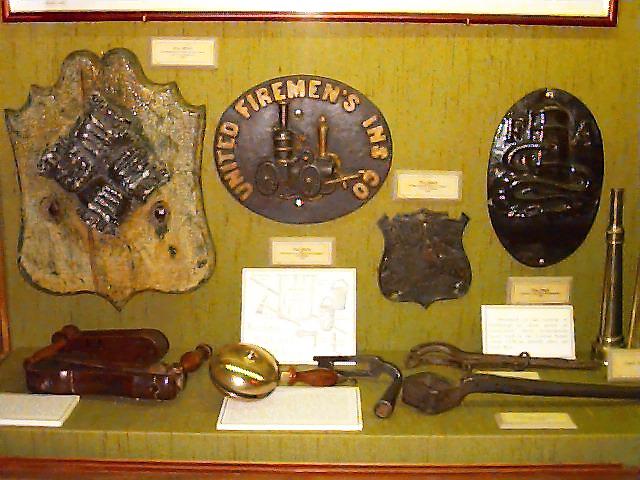 Hand rung alarms for the city ward fire marshal and a fireman's bed key for disassembling metal beds to remove them from burning buildings.
Hand rung alarms for the city ward fire marshal and a fireman's bed key for disassembling metal beds to remove them from burning buildings.
City Council, upon creating or recognizing a fire or hook & ladder company, would supply it with an engine or ladder wagon; engine house; and such apparatus as a hose carriage; hose; buckets; and ladders. Uniforms for the men were not supplied, so each year the individual companies would hold a Fireman’s Ball to raise money for such needs. These occasions were of great social importance, and the ladies and gentlemen of the city turned out in their finest apparel. Seldom was the ball of an established company unsuccessful.
The members of the individual fire companies had strong social and political ties. Neptune No. 1 was, in its early days, a strong Whig organization. Davey Crockett No. 2 and later Franklin No. 2 were for the most part Democrat and Locofoco (radical Democrats). Erin No. 2 was made up of Irishmen, as were many members of Croton No. 3, named for the Croton Aqueduct in New York State. No. 3, created by council on June 7, 1866, was an Irish Catholic temperance company. Germania No. 4 was a strong German organization, as was the Teutonic Fire Guards. Hibernia No. 5 was Irish, and No. 8 was the east side company. Independent Relief H & L Co. No. 1 was, throughout its 20 1/2 years of existence, an organization of merchants of the city.
In early June of each year, at least from the 1840s, the department held an Annual Fireman’s Parade. The members of each company would dress in a distinct uniform. The uniforms worn at the 1856 parade were noted in the Toledo Blade: Neptune No. 1 had red shirts and grey pants; Erin No. 2 reported as having only a large green banner; Croton No. 3 had white shirts and black pants; Germania No. 4 wore a black velvet uniform consisting of a helmet like that of a Prussian soldier, black velvet coat with red collar, and black pantaloons. It was noted that in case of fire the fire guards were to wear a red cloth badge with the initials F.G. on their left arm.
Every member of the fire department was expected to carry a key to the door of his engine house. Another key was hanging from the door of the engine house (the reason for this could not be found) at all times, and yet another was left in the neighborhood.
A good description of a volunteer company’s engine house appeared in the Toledo Blade of December 11, 1854: "NEW ENGINE HOUSE - Fire Co. No. 1 have their new engine house nearly completed. It stands on Cherry St., about midway from the corner of Cherry and Summit and the Canal bridge. It is built of brick, two stories high and all the exterior woodwork is covered with sheet iron. On each side of the single front window of the second story is a carved block of grey stone set in brick. On these blocks are representations of a couple trumpets crossed and ‘No. 1’ enclosed in a wreath, these chiseled in relief. This building thou’ small when finished, will be an ornament to Cherry St."
Shortly after Patrick H. Galloway joined the department as a torch boy, the burning of the Indiana House took place. It was a four story brick hotel that extended from Perry Street about half the block near Monroe Street. On the remainder of the block toward Monroe Street were frame stores. As Mr. Galloway recalled, Toledo, at this time, had the worst gang of thieves that he had ever seen in the 1800s. While the fire burned, these thieves began burglarizing, and the company of which Mr. Galloway was a member was called upon by the Chief Engineer to check the thieves at their work. The company made short work of them, driving them back and retrieving the goods they had stolen. In doing so, one of the firemen, James Burns of the fifth ward, was hit on the side of the head with a brick and suffered a broken jaw. The boarders of the hotel were robbed of their valuables, excepting those saved by the efforts of the firemen. Mr. Galloway stated in May 1900 that it was one of biggest fires in Toledo in the last century.
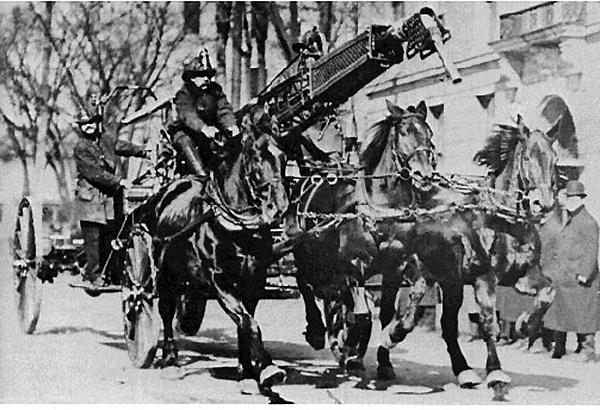 Horse Wagon
Horse Wagon
The next hottest fire in Mr. Galloway’s recollections occurred on a Sunday afternoon, when Charles A. Rowsey’s barn burned. The day was a hot one, suffocating in the extreme. Firemen were overcome by heat and were prostrated on the street. While taking a short rest some of them spat blood, but they went at the fire again. The Toledo Blade of Monday, May 14, 1855 notes the fire thusly: "FIRE The barn of Mr. C. A. Rowsey was destroyed yesterday in this city, about 4 o clock P.M. Two horses, two carriages, hay and other property were destroyed. We regret to hear that the property was not insured, and that the loss of Mr. Rowsey will amount to $1,500. The flames when discovered had proceeded too far to be arrested. It ignited from a match with which boys lighted a cigar."
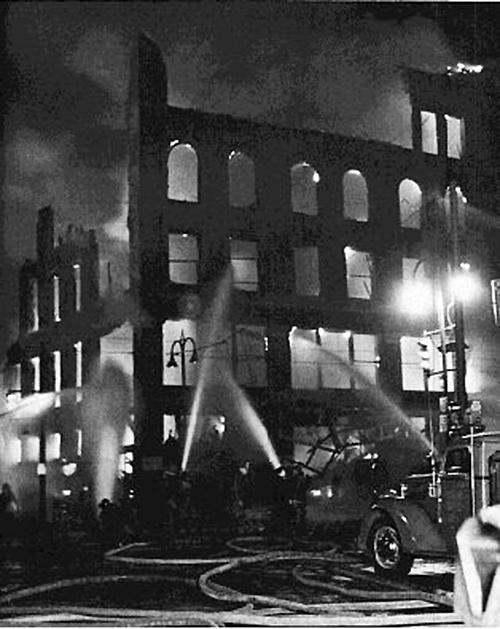 Harry Auto Stores Fire, Jan. 20, 1944.
Harry Auto Stores Fire, Jan. 20, 1944.
The burning of the houses of Judge Dunlap and Mr. Treadwell he described as roasters, as well as the "Seven Sisters Fire" on Summit Street. Mr. Galloway also recalled that the first engine house was built at the corner of Superior and Locust Sts.
At the scene of a large fire, the women of the neighborhood would set up tables of food and drink for the firemen, but the firemen paid more attention to the fire than to the refreshments. After the fire, however, the firemen (not having cleaned up) were often invited into someone’s home for refreshments, and this invitation was accepted. The next day the men of that fire company would place a ‘Card of Thanks’ in the Toledo Blade and express their gratitude for what the ladies had done.
Another interesting fact concerning the volunteer firemen was that at the time of the outbreaks of cholera in 1849 and 1853, the members of the department would turn out when a fireman had died, dig his grave, and bury him.
In November of 1872, a number of men in the city organized to assist the fire department (which was a paid department by this time except for No. 8) in pulling the steam engines to fires because the horses of the city were sick with epizooty disease.
On October 6, 1873, Toledo City Council decided by resolution to sell the first class Jefferson Hand Engine of Fire Engine & Hose Co. No. 8, thus bringing to an end the existence of the last volunteer fire company. It also ended the part paid, part volunteer Toledo Fire Department, which had existed since 1867.
Our Chronological History, 1837-1976 (from History of the Toledo Fire Division, 1837-1977 by John Killits)
 The fire engine of Neptune Fire Engine & Hose Co. No. 1
The fire engine of Neptune Fire Engine & Hose Co. No. 1
1837
City Council appointed a committee to ascertain the cost of providing two fire engines for city use.
The first effort to organize a Fire Department was by way of a resolution passed by City Council on November 27, 1837. The resolution provided that whenever a number of citizens, not less than forty, should associate themselves together for the purpose of forming a fire company, the company should be put in possession of an engine, hose-wagon, hooks and ladders, and other equipment. The companies were to be designated by numbers.
Charles McLean was elected Fire Chief of the Volunteer Fire Department. On November 27, 1837, the first Volunteer Company was organized. The first Fire Wardens were appointed on December 29, 1837.
In December of 1837, the first engine house was built on Cherry Street between Huron and Superior. It was known as Engine House No. 1. At about this time, two engines were received from a Mr. Platt on which the freight was paid amounting to $86.93.
1838
The city was divided into three wards, which remained in effect until July 2, 1848, when a fourth was established. Total cost of operation in 1838 was $45.05 plus the cost of two engines $1,909.50. Davy Crockett Fire Engine and Hose Company was formed February 3, 1838.
1840
On November 30, 1840, City Council elected officers for the Fire Department.
The first ordinance for regulating the Toledo Fire Department was passed. It provided that the Department was to consist of a Chief Engineer and such other members as should be appointed from time to time by Council; that one (1) fireman in each ward be appointed a Fire Warden, whose duties were to see that dwellings and business places were properly supplied with fire buckets; that members report for exercise; and cleaning equipment the first Monday of each month from April to October each year. (City Ord. Vol. 1, p. 47)
1842
On May 3, 1842, Council took action and built a new station on Summit, between Adams and Cherry. Franklin Fire and Hose Company formed.
1847
On September 24, 1847, Council provided for purchase of lot 161 Port Lawrence Division and the erection of an engine house not to exceed $2,500.
1851
The department consisted of two engine companies and a hook and ladder company.
It seems that there was no way of giving a general alarm of fire, as on June 14, 1851, an ordinance was passed providing that the foreman of each company should procure a key to the Episcopal Church and keep the same in the rooms of said companies. It was further provided that in case of alarm of fire, the first member of either company to arrive at the room of his company should proceed at once to the church and ring the bell until relieved by the sexton, or until the bell of the Catholic Church should be rung, and that the company whose member should first ring the bell should be paid a reward of $2.00, to be given said member upon the vote of the company. The fine for failing to ring the bell by any member who should be first on the ground was placed at $5.00, while his company forfeited all title to a reward for any service at such fire. The sexton of the Catholic Church was also liable to be a loser by this ordinance, for it stated that unless he rang the bell of that church within five minutes of the ringing of the Episcopal bell, he should forfeit the amount due him for ringing the bell during the current month. Hardest of all, it provided that the premium offered for the earliest ringing of the Episcopal bell would not be paid unless the fireman ringing the same should promptly thereafter lock the door of the church and return the key to its proper place.
1852
By the end of 1852, it is believed that there were three engine companies, known as Neptune No. 1, Erin No. 2, and Croton No. 3. 1853
On October 21, 1853, Council approved the purchase of an engine for Germania Fire Company No. 4.
1857
The department consisted of five chemical and hose companies, (two steam and three hand), one hook and ladder company, and one fire guard (Teutonia).
1858
Records show that in 1858 the department consisted of the following: Fire Co. "Erin" No. 2 - on Adams Street, west side, between St. Clair and Summit; Fire Company Hook & Ladder No. 1 - at the same location; Fire Engine and Hose Company No. 2 - disbanded; No. 3 - Monroe Street; No. 4 - Monroe St., No. 5 - St. Clair St.; No. 6 - Summit St., and one fire guard company. No street numbers are given.
1860
The records show that in 1860 the department consisted of the following: Hook and Ladder Company No. 1 - west side of Adams, between Summit and St. Clair; Engine and Hose Company No. 1 - west side of Cherry, between Superior and Huron; No. 2 - disbanded; No. 3 - west side of Monroe St., between St. Clair and Superior; No. 5 - same as No. 3; No. 6 north side of Summit, between Lagrange and Elm; No. 7 -west side of Monroe between St. Clair and Superior.
1861
It is stated that in 1861 the department consisted of, in actual service, six engine and hose companies, one Hook and Ladder Company, and one fire guard.
1863
There were recorded 22 fires with a total loss of $285,000 during this year. Of this, $225,000 was at the Michigan Southern Elevators fire. Two steam engines, three hand engines, and one Hook and Ladder Company were in use.
1866
The last year of volunteer fire service showed the following stations and apparatus in service. Station No. 1 - Lagrange and Swan Lane; No. 2 - Cherry and Eagle Lane (1st class LaFrance Engine, Muskegon Chemical Engine, and four wheel hose cart); No. 3 - Water, between Adams and Madison; No. 4 - St. Clair, between Perry and Washington; No. 5 - Broadway and Logan (1 LaFrance Engine and 1 Muskegon Hose Wagon); No. 6 - to be located in East Toledo, Starr and Main; No. 7 - Corner of Franklin and Bancroft (1 Seagrave Hook & Ladder and 1 four wheel hose carriage).
1867
Elias Avery was Chief of the Department. After Toledo became a City of the first class, Council provided for the first paid Fire Department. For each steam fire engine there was to be one (1) fireman, one (1) pipe man with full pay, and three (3) pipe men under part pay. The Chief Engineer was to hire and discharge all members by and with consent of Council.
These firemen worked ten (10) days on and one (1) off, with meal hours of one hour and twenty minutes, three times a day (a day was 24 hours). The pay scale was $700.00 a year.
A new station was being erected, and it was not quite ready for occupancy when No. 3 Company was placed on the city payroll. A building occupied by Arm’s Livery Stable was used as the engine house for several months. The new station was built on Water Street near the corner of Madison and was known as Station No. 3. It was completed in 1868.
1868
The City Directory lists the following: Steam Fire Engine House 1-99 Cherry St.; 2-89 St. Clair St.; 3 - Water, between Madison and Adams; 6-102 Lagrange St.; Relief Hook and Ladder Company, Adams opposite Trinity Church; and No. 8 – opposite First St., East Toledo.
1869
An Ordinance Council provided that the Chief Engineer be a full time employee. And, since there was no waterworks system, and because the canal was abandoned, council provided for the construction of 15 wooden cisterns in various locations for use of the Fire Department.
1870
Christ Woehier was Chief of the Department.
1872
Number 2 Fire Station was erected on Cherry Street at Eagle Lane, at a cost of $7,000. It was abandoned in 1953.
On December 15, 1872, the first fireman to be killed in action happened at a fire on Ottawa at Lafayette. A pipeman from No. 4 Company, James Welch, was killed in a fall at a fire that burned the Hall Block, and Tobacco Works. A fire at the Wilcox Co. on Water Street almost killed a whole Company, had they not emerged from the building before it collapsed.
1873
The following stations were erected: No.5 Broadway and Logan; No. 7 - Franklin and Bancroft; No. 8 - Division and Indiana; No. 1 - Lagrange and Swan Lane. Also, a temporary water works in service at Boyd’s Factory, St. Clair Street and Swan Creek, with 73 hydrants in the city.
1878
John Avery was Chief of the Fire Department. District Telegraph and Telephone Companies were organized and fire alarms were successfully received over both systems.
1884
First chemical engine introduced in department. Firemen’s Relief Association organized.
1885
John Nagely, Chief of Fire Department. No. 3 Fire Station Headquarters, Jefferson and Ontario Streets erected.
1887
An act was passed by the State Legislature creating a Board of Trustees of the Firemen’s Pension fund. First full paid fire department. Department was fully uniformed.
1889
The control of the fire department passed from council to a bipartisan commission. The legislature provided that in every city the management and control of the fire department should be vested in a Board of Fire Commissioners, composed of four members, two to be elected and two to be appointed by the Mayor, one from each political body.
First Aerial hook and ladder truck was purchased.
1890
Thomas R. Cook, Chief of the Department. Christopher F. Wall, Chief of Fire Department.
1893
No. 1 Fire Station, Bush & Erie St. erected.
No. 4 Fire Station, Monroe & Bancroft erected.
No. 9 Fire Station, Broadway & Orchard erected.
No. 10 Fire Station, Oak & Fassett erected.
The first Negro fire company was appointed to No. 11 Station on 315 Water Street on October 1, 1893. (Formerly Station No. 3)
1894
January 3, 1894, a fire which burned the King’s Elevators; the Chamber of Commerce; the
Wonderland; and several other buildings, cost the life of Fire Captain James Fraser, of Engine No. 1. Several other firemen were severely injured.
1895
A new station was erected for No. 6 Fire Station at Starr and Main Streets.
1896
Records Indicate a List of Stations and Their Apparatus as Follows:
No. 1 Located at Bush and Erie - 2nd class Ahrens Engine and 1 combination hose wagon and cart.
No. 3 Located at Jefferson near Ontario - 1 Babcock Aerial Turntable Extension Hook and Ladder, 1 Seagrave hook and ladder, 1 Muskegon Chemical Engine, and 1 Milburn Hose Wagon.
No. 4 Located at Monroe near Bancroft - 1 Clapp and Jones Engine, 1 combination hose wagon and chemical.
No. 5 Broadway and Logan - 1 Clapp and Jones Engine
No. 6 Main and Statt - 1 Silsby Engine, 1 Milburn Hose Wagon, 1 Champion Chemical Engine, and 1 Seagrave Hook and Ladder.
No. 7 Franklin and Bancroft - 1 Seagrave Hook and Ladder, and 1 four wheel hose carriage.
No. 8 Division and Indiana - 1 Ahrens Engine and 1 four wheel hose carriage.
No. 9 Broadway and Orchard - 1 Milburn combination Hose Wagon and Chemical.
No. 10 Oak and Fasset - 1 combination hose wagon and Chemical.
No. 11 315 Water near Madison - 1 Milburn hose wagon and 1 Champion Water Tower.
1899
No. 12 Fire Station, Summit & Cleveland erected.
No. 13 Fire Station, Front & Paine Ave. erected.
No. 14 Fire Station, Lagrange & Everett erected.
No. 15 Fire Station, Wayne near Gibbons erected.
Gamewell Fire Alarm System placed in service. The first fire alarm received from a street alarm Box 212 located at Broadway and Ottawa on February 20, 1899.
1900
Hours changed to six days on and one day off.
1902
William F. Mayo was Chief of Fire Department.
1903
Control of the fire department passed from the Board of Fire Commissioners to a Board of Public Safety by virtue of the new municipal code of that year.
1906
No. 16 Fire Station at Detroit & Woodland Avenues erected.
1907
Fire Department shop at John R. and Division Streets erected.
1908
No. 17 Fire Station, Detroit & Glenwood erected.
1909
Board of Public Safety abolished and department placed under Director of Public Safety.
1910
State Civil Service Law in effect and first commission was appointed.
1912
A $200,000 bond issue was approved for motorizing the department. Plans called for the selling of 100 horses to offset the bond issue.
Champion Water Tower placed into service, No. 6 station. First auto equipment (three Chief cars) placed into service.
1913
On May 17, 1913, a gas tractor was attached to an engine at No. 3 House. It reached speeds of 25 mph. The tractor was made by the Knox Tractor Co. of Springfield, Massachusetts. They sent three for free use on a trial basis. The other two went to stations No. 2 and No. 5.
1914
George Fraser, Chief of Fire Department.
First motorized fire apparatus placed in service:
1 - 85’ American LaFrance Aerial Hook & Ladder
3 - Knox-Martin 3 wheel tractors
3 - Peerless City Service Hook & Ladder Trucks
1 - Seagrave City Service Hook & Ladder Truck
1 - Peerless Combination Hose & Chemical Truck
5 - Willys Knight Chief Cars
The Charter of the City of Toledo provided that the Safety Department was to be under the jurisdiction of a Safety Director appointed by the Mayor, and the Fire Department became the Division of Fire in the Department of Public Safety.
1915
Louis H. Elling, Chief of Fire Division.
The High Pressure System was placed in and service hours changed to 4 days on, 2 days off
1916
The last horse retired from the fire service from No. 15 Station at Airline and Gibbons Streets on August 12, 1916. The Division of Fire was completely motorized.
By March 25, 1916 there were 2,250 fire hydrants, 66 of them high pressure.
1918
International Association of Firefighters chartered. Local 92, No. 3 Station (headquarters) was rebuilt on the site of the razed former station built in 1885 at Jefferson and Ontario.
1919
First motor-driven pumper purchased and first steamer replaced (November 1)
1920
Firemen began working the two-platoon system of 48 hours on duty, 48 hours off duty (Sept. 16). No.
18 Fire Station at Sylvania & Peak St. erected.
1921
No. 11 Fire Station at 315 Water St. abandoned and No. 11 Company moved to new quarters at the foot of Madison Avenue and the Maumee River.
1922
No. 19 Fire Station at Stickney & Ketcham Ave. erected.
No. 15 Fire Station at Wayne & Gibbons Street abandoned and No. 15 Company moved to present station on Fearing Blvd. near Airline Avenue.
1927
Fred J. Myers, Chief of Fire Division.
No. 1 Station rebuilt at Bush & Erie Sts.
1929
Fire Prevention Bureau created (June 1)
1930
Drill School created (September 1)
March 1st, running out of No. 5s, the last steamer was replaced by a pumper.
1931
No. 21 Fire Station at Glendale and Detroit Avenue erected.
No. 23 Fire Station at Central and Oatis Street erected, known originally as No. 22
No. 3 moved to 20 North Superior Street on March 3, 1931 (the old jail). Old No. 3 at Jefferson and Ontario abandoned.
1932
Radio broadcasting of fire alarms began (Aug. 9)
Positions of Engineers and Assistant Engineers abolished by council.
1933
On June 15, 1933, No. 11 Fire Station at the foot of
Madison Avenue was abandoned and No. 11 Hose Company moved to No. 3 Station at 20 N. Superior St. Rescue Squad placed in service (October)
1935
Firemen began working the three-platoon system: 8 hours a day, 48 hours a week (June 1). Fire Stations Nos. 12, 15, 19, and No. 23 closed; No. 11 Company, running out of No. 3s, and the Drill Tower were disbanded (June 1)
Fred T. Schlorf, Chief of Division of Fire, 1936
No. 13 and No. 18 Hook and Ladder trucks out of service (May 1)
Short wave radios installed in chief cars (May 2)
The position of Chief Inspector in the Fire Prevention Bureau created.
1936
August 1: position of Assistant Chief abolished and position of Deputy Chief created
November 1: No. 23 Fire Station reopened
1937
April 1: No. 12 Fire Station reopened
July 1: No 15 Fire Station reopened
December 1: Firemen began working 24 hours on and 48 hours off
1938
June 1: Drill Tower erected at the rear of No. 23 fire Station, Central and Qatis. Position of Drill Master created.
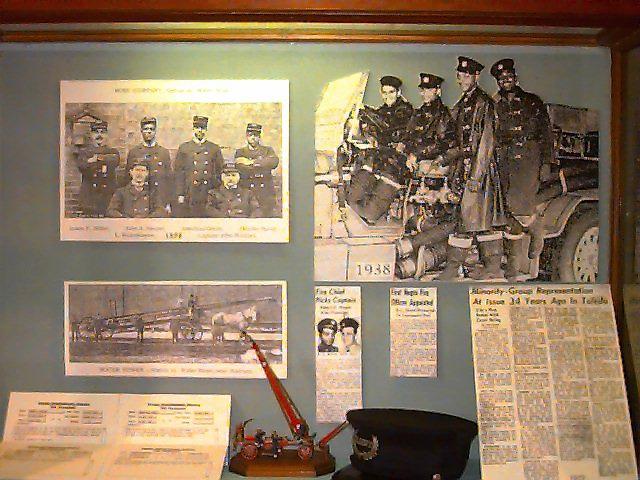 Colored fire company for No. 8 Station appointed.
Colored fire company for No. 8 Station appointed.
July 16: Colored Fire Company for No. 8 Station appointed.
August 16: No. 19 Fire Station reopened.
1939
June 16: No. 2 Hook and Ladder out of service
June 17: Colored fire company dismissed ("illegally appointed")
1940
July 16: No. 24 Fire Station at Summit and 114th Street opened through the annexation of Point Place
1941-1945
Fifty men of the Toledo Fire Divisions were drafted for Military Service and six of them were killed in the line of duty.
Many members of the Fire Division served with the Civilian Defense Corps as air raid wardens and first aid instructors during the war. Two firefighters were assigned to the chiefs cars during the war years and were called commandos.
1946
Patrick J. Daly Chief of Fire Division
1950
No. 4 Fire Station rebuilt at Monroe and Bancroft.
1951
Karl B. Scheidler Chief of Division
New No. 6 Fire Station erected at Starr and Euclid; old station abandoned (Opened March 12)
1952
Arnold F. Papenhagen Chief of Division
1953
New No. 1 Fire Station erected at Huron and Orange; old Station No. 2 and No. 3 abandoned (opened May 18); designation of original No. 1 Station changed to No. 3.
August 1: No.3, No. 16, No. 17 Ladder Companies moved to No. 12, No. 15, and No. 4, respectively; No. 7 District Chief moved to No. 17 and No. 4 District Chief moved to No. 16.
1961
May 1: No. 6 Rescue Squad placed in service at No. 6 Station
June 10: the worst day in the history of the Toledo Fire Division occurred at a gasoline truck explosion on the Anthony Wayne Trail which killed four firemen (six were seriously injured) and injured 81 civilians.
1962
January 1: Firefighters’ hours reduced to 54 hours per week.
June 10: Maumee Chemical Company explosion; 10 civilians killed, 40 civilians injured
1963
June 10: Fire Fighter memorial dedicated.
1964
March: Fire Department widow’s pension raised to $90.00 per month
March 11: No. 14 Fire Station at Lagrange and Everett Streets, closed 7:00 A.M.
March 11: No. 25 Fire Station at Central and Meadowwood opened
March 15: Fifteen new men appointed for No. 26 Fire Station; division strength increased from 487 men to 502
March 17: No. 26 Fire Station opened at Airport and Byrne; station obtained from Adams Township by annexation
December: Fire Prevention Code adopted by City Council and added to the Toledo Municipal Code
December 28: No. 14 Fire Station opened. This station was obtained from Adams Township by annexation. It was formerly known as Adams Township No. 1, located at Reynolds and Hess. Fifteen new men were appointed for No. 14 Fire Station; strength increased to 517
1965
January 25: No. 23 Fire Station located at Central and Oatis closed at 7:00 A.M. and relocated at Trilby Volunteer Station at Secor Road near Alexis, by annexation of Washington Township.
Clothing allowance increased to $100.00 per year.
No. 19 Station located at Stickney and Ketcham was closed and relocated at the new station on Stickney opposite the Kaiser plant.
1966
March 1: fifteen privates were promoted to Lieutenants to serve as relief officers.
March 11: No. 23 Company moved to their new quarters at Laskey and Goodwill at 7:00 a.m. and the old volunteer station on Secor closed.
$5000.00 group life insurance program started; clothing allowance increased to $150.00 annually and a $325.00 flat raise granted.
November: 1/2 Penny for Progress Levy passed by voters, enabling City Council to appropriate funds for the replacement of four Fire Stations; officers appointed for ladder trucks.
1967
January 2: authorized strength increased to 541 men
No. 5 Rescue Squad placed in service at No. 25
July 21: thirty new firemen appointed; strength increased to 571 men
The new position of Administrative Deputy Chief was created and a new district created
July: riots hit Toledo; one firefighter killed, many injured; record number of alarms answered
September 13: new No. 11 Fire Station opened located on Airport and Seymour. Old No. 26 Station located on S. Byrne and Airport to be used by the Fire Prevention Bureau
December 26: New No. 12 Station opened on Suder near Manhattan Boulevard; old No. 12 Station located on Summit at Cleveland closed and turned over to the Division of Parks
1968
Fire Division placed on 52-hour work week.
March: Toledo’s first fireboat, the "Ewald Bode," placed in service
April 17: No. 5 Station at Broadway and Logan closed; new No. 5 Station at Ontario and Washington opened with #5 Pumper, #8 Pumper, and #5 Ladder; No. 8 Fire Station closed.
July 1: Chief A. F. Papenhagen retired
July 4: Chief Eulan G. Tucker appointed Chief
August: Fire Department Shop moved from Indiana and Division to the Municipal Garage on Albion Street. Position of water officer established.
1969
March 26: No. 2 pumper put out of service, men reassigned; No. 8 pumper put out of service, men reassigned
April 1: Two-man emergency units placed in service at No. 6, 15, 23, 24, and 25 Fire Stations
June 1; eight new pumpers ordered for Fire Division. Deputy Chiefs placed in charge of four bureaus:
No.1 Training and Maintenance
No.2 Fire Prevention
No.3 Communication and Special Services
No.4 Fire Extinguishment and Rescue
July 1: Radiological Monitoring Unit established with fifteen members
October 31: No. 7 Fire Station rebuilt at Franklin and Bancroft
1970
June 11, 1970: No. 4 Fire Station at Monroe and Bancroft closed; building turned over to Board of Community Relations
1971
July 1: new No. 4 Fire Station at 3940 Hill Avenue opened. No. 12 ladder out of service; tactical units in service
1972
October: year-round program on fire safety in the Toledo Schools with Fireman Freddy started
1973
April 19: first woman applied to become city firefighter
April 20: Fire Training Center opened at Toledo Express Airport
August 7: Fire Division acquired two amphibious Larks from the United States Government
1974
April 29, 1974: civilian employee, confidential secretary to the chief appointed
1975
January 1: seven mini-size pumpers (scats) placed in service
February 7: Firefighters went on an 8 hour day, three shifts, forty-hour work week
May 7: Tiedtke’s Department Store burned at Summit and Adams Streets
May 5: two emergency Life Squads placed in service
Old No. 18 Fire Station at Sylvania and Peak Avenues closed; new No. 18 at 5225 Lewis Avenue opened
November 7: Voters passed charter amendment allowing Council to regulate firefighter hours
1976
February 6, 1976: maintenance shop moved to Wall Street Armory
March 4: Firefighters end eight hour shift, forty-hour week and return to a 24 hours on, 48 hours off, 52- hour work week
March 5: twelve firefighters laid off, reducing strength to 554
April 17: Chief Eulan G. Tucker retired
April 18: Deputy Chief Raymond G. Seelman named Acting Chief
May 1: third Life Squad placed in service Fire Station at No.18
October 15: Carl W. Neeb appointed as Chief of the Fire Division
November: Firefighters work week reduced to 50 hours, effective 1-1-77
December 1, 1976: New Training Facility opened across from the Toledo Express Airport
A History of the Toledo Fire Department
(From John M. Killits, ed. (S.J. Clarke Publishing Co.: Chicago, 1923, pp. 307-313)
The first movement toward providing fire protection for the City of Toledo was made on May 29, 1837, when the council appointed a committee to ascertain the cost of two fire engines. Sometime that summer, two engines of the old hand-power type were purchased from a Mr. Platt, of Buffalo, New York, for S1,909.50. In September, Hoisington & Manning were employed to erect two engine houses - No. 1 on Cherry Street, not far from Summit, and No. 2 at some suitable point in the western part of the city. House No. 1 cost the city $68.00 and No. 2 cost $13.00. On November 27, 1827, the council passed a resolution to the effect that whenever forty or more citizens should form themselves into a fire company, such company should be placed in possession of an engine, hose, hose cart, hooks and ladders, etc. The resolution also provided that the companies should be designated by numbers: the first company formed to be No. 1, the second, No. 2, and so on.
On December 11, 1837, an ordinance regulating the fire department was passed by the council. Among other things, this ordinance provided that "Every owner or occupant of a building shall keep good fire buckets, made of leather, as follows: For a building with one or two fireplaces or stoves, one bucket; for buildings with more than two fireplaces or stoves, one bucket for every two such; the buckets to hold three gallons each." The ordinance also provided for the appointment of fire wardens - one for each of the three wards - and on December 29th, James M. Whitney, Worden N. Richardson, and Daniel Segur were appointed.
Engine Company No. 1 was organized late in the year 1837, but its records, if any were kept, seem to have disappeared. In looking through the old newspaper files, the first mention found of a No. 2 company is on November 21, 1838, when Joseph B. Gardner, Secretary, gives notice of a meeting of the "Davy Crockett Fire Engine and Hose Company No. 2." to be held on the first day of December, "at the Engine House." In February of 1839, J. W. B. Hyatt, Second Assistant Foreman, issued a call for a meeting of the same company. It would no doubt be interesting to know the names of these early volunteer fire companies, but the writer has been unable to find them.
At a meeting of the council on November 30. 1840, Edward Bissell was elected Chief Fire Engineer; Richard Mott, First Assistant; Walter Titus, Second Assistant; and Junius Flagg, Peter H. Shaw, and William Hoskins, Fire Wardens for the three wards, respectively. At the same session, a resolution to organize two hook and ladder companies was adopted and the engineer was directed “to procure two fire hooks and two ladders of sufficient length and strength for the purpose for which they are intended.”
By this time, the interest and enthusiasm of the volunteer fire department seems to have waned, for on February 8, 1841, the council instructed the committee of the fire department "to ascertain whether any fire companies do in fact exist at this time, and report upon the expediency of disbanding the same." The committee reported that the companies nominally in existence were inactive and a reorganization of the department was recommended. On the 22nd of the same month, C. W. Hill; W. N. Richardson; and C. G. Shaw were authorized to organize a company, "to be known as Fire Engine and Hose Company No. 1, to be the successor of Engine Company No. 1, which is hereby disbanded." Two days later the company was organized with the following members: Edson Allen, Aldrice A. Belknap, C. H. Bentley, Leverett Bissell, S. S. Blanchard, Charles Border, Manly Bostwick, S. H. Bradford, George P. Clark, Henry Clark, H. G. Cozzens, Joel W. Crane, Samuel Eddy, W. H. Elder, A. W. Fairbanks, Junius Flagg, J. J. Fullerton, Elijah S. Hanks, C. W. Hill, Joseph Jones, Valentine H. Ketcham, R. N. Lawton, T. N. Mount, B. P. Peckham, W. H. Raymond, John Ream, George Redding, George H. Rich, W. N. Richardson, Erastus Roys, Daniel Segur, Cornelius G. Shaw, Thomas Southard, and and Walter Titus, Jr.
J. J. Fullerton was elected Foreman; Cornelius G. Shaw, First Assistant; Leverett Bissell, Aecond Assistant; Erastus Roys, Secretary; and William R. Raymond, Treasurer. Engine House No. 1 was remodeled and improved and the company was placed in possession. For some time, this was the only fire company in the city. Better discipline prevailed after the reorganization and the company proved to be more of a success in fire fighting than those which had preceded it. A No. 2 company was organized in the spring of 1842, but the names of the members cannot now be learned. On May 3, 1842, the council passed a resolution directing the chief of the department (David Crane) to "organize a hook and ladder company and superintend the erection of a house for the same, located on Summit Street, between Adams and Cherry streets, for which he shall receive compensation at the rate of $1.50 per day."
Mr. Crane delegated the work of building the house to his first assistant, Mayor Brigham (his name was Mayor), and the structure was completed sometime in July. The city now had two engine companies and a hook and ladder company, as well equipped as those in most cities of Toledo's size. During the next five years, considerable progress was made by the department. A third company had been organized and on September 24, 1847, the council passed an ordinance providing for the purchase "of a portion of lot No. 161, Port Lawrence division, and the erection thereon of an engine house, the cost of which shall not exceed $2,500." This house, when completed, was occupied by the No. 3 Engine and Hose Company.
Under the ordinance of March 20, 1848, the Toledo Fire Department began to put on style," as the following extracts will show:
"The mayor and aldermen, acting as such at fires, to bear a staff, painted white, with a gilded flame at the top; the chief engineer a leather cap. painted white, with gilded combs, and having a fire engine and the words 'Chief Engineer' in gilt in front, and carrying a black speaking trumpet with the same words in white and a gold rim; the assistants to wear white leather caps, with black combs, gilded front, and the words 'Engine No_' in black: . . . Fire wardens to wear hats with black rim, the crown and front white, with the word 'Warden' in black, and carry trumpets; foremen to wear black leather caps, with white fronts and the words 'Foreman No._' in black; foremen of hook and ladder companies to have a hook and ladder in black on their caps."
The ordinance provided that all persons present at fires should be subject to the orders of the mayor and aldermen, fire wardens or other officers, and made liable to arrest and a fine of $5.00 for refusing to obey such orders. Members of fire companies were required to meet at their respective houses on the first of each month for the purpose of exercise and for cleaning the apparatus. A premium of $10.00 was provided for the company which should first arrive at a fire with its apparatus ready for use, and S5.00 for each company arriving in ten minutes thereafter. The several companies were required to meet in joint convention in March of each year and nominate a chief engineer and two assistants, to be submitted to the council for confirmation. Sextons of churches provided with bells were required to ring the same for a period of twenty minutes, immediately upon an alarm of fire. Failure to do so was punishable by a fine of $2.00.
One might reach the conclusion that, with all the "pomp and circumstance" of white staffs, gilded caps and speaking trumpets, the Toledo fire department was more of a parade than a utility. But there were many earnest, conscientious members of the several engine companies, whose foremost ambition was to render effective service at fires. Among these may be mentioned Junius Flagg, B. P. Peckham, Coleman I. Keeler, Richard Mott, Peter F. Berdan, Cornelius G. Shaw, Valentine H. Ketcham, Mayor Brigham, Peter H. Shaw, E. B. Brown and a number of others, who were or afterward became prominent in the business circles of Toledo.
By the ordinance of June 14, 1851, the council directed that the foremen of Engine Companies No. 1 and No. 2, and Hook and Ladder Company No. 1, should each procure a key to the Episcopal Church and keep the same in the houses of said companies. In case of fire, any member of either company was authorized to open the church and ring the bell "until relieved by the sexton of the church, or until the bell of the Catholic Church shall begin to ring." To stimulate watchfulness, it was provided that the company whose member should be the first at the church and the first to ring the hell should receive a premium of $2.00, which the company might give to the member by vote.
In 1852, Fire Company No. 4 was organized. As most of its members were Germans, it was named the "Germania Fire Company." On October 27, 1853, the council passed an ordinance providing for the purchase of an engine for this company. At the same meeting, an appropriation of $1,000 was made for the purchase of new hose, "provided no commission shall be charged or received by the chief engineer for the purchase of the same.
The decade between 1853 and 1863 witnessed several important improvements in the fire department. Two new companies and two companies of fire guards were organized, and the city spent considerable sums for new engine houses and equipment. In 1861, a new house was erected for Engine Company No. 1, on Cherry Street between Superior and Huron streets. Connected with this house there is a little incident, which contains both romance and pathos. William P. Scott, who was very much interested in the new engine house, enlisted as first lieutenant of Company K, Twenty-fifth Ohio Volunteer Infantry. When the building was completed, a picture of it, with the company; engine; and hose cart in front, was taken and sent to Lieutenant Scott at Cheat Mountain, Virginia, where he received it in August of 1861. He carried the picture with him during the remainder of his service and upon his return used to tell how homesick he would get when he looked at it. Lieutenant Scott, after the war, served for thirty-three years upon the Toledo police force. He died in 1898 and his daughter, Mrs. Nellie Young, had the picture enlarged and framed for her parlor.
The annual report of Robert Cummings, Chief Fire Engineer, in March, 1863, says: "There have been during the last year 22 fires, involving a loss of S285,000, which was covered by insurance to the amount of S131,000, making a total loss over insurance of $154,000. Of this loss, $225,000 occurred at the burning of the Michigan Southern Elevators. The above returns of loss are as accurate as could be obtained.
"There are now connected with the fire department, two steam engines, three hand engines and one hook and ladder company, with their hose carriages and carts - all in good order with the exception of the hose carts, which are now being made. At the close of my term of office, I wish again to mention the importance of having cisterns built at various points through the city for fire purposes. It is also important to have a coal cart to run to fires, to carry coal to the two steamers. The city should own the cart and make arrangements with a drayman to haul it to fires."
At the time this report was made, the Civil War was at its height and little attention was paid to local affairs such as building fire cisterns. In 1866, Toledo had a population of 20,000 and was advanced to the rank of a city of the first class. The old volunteer department was then superseded by a paid department, with the exception of the engine companies in the Fifth and Sixth wards, which were also placed upon a paid basis in 1868. In the early history of the department, when the old hand engines were used, these engines were drawn by hand to the scene of the fire. With the pumps properly manned, one of these machines would throw a stream from 250 to 300 feet through an inch and a quarter nozzle. After the introduction of steam fire engines, arrangements were made with some owner of a team of horses to draw the engine to fires. This plan was abandoned when the department went upon a paid basis, the city then purchasing horses for the several fire companies. With the invention and improvement of the automobile, motor-driven fire apparatus came into use and the horses were discarded.
Under the charter of 1913, the fire department is under the Director of Public Safety, the chief of the fire division having exclusive control of the stationing and transfer of firemen. He may suspend a fireman, though the suspended member of the department may appeal to the civil service commission, whose decision shall be final. At the beginning of the year 1922, Toledo's fire department numbered 411 men. There were then eighteen fire stations, or engine houses, fully equipped with modern firefighting apparatus, and an electric alarm system with 234 signal boxes, so located that no part of the city is without fire protection.
News clippings about the Department
An 1875 Inventory of the Equipment of Engine House No. 1
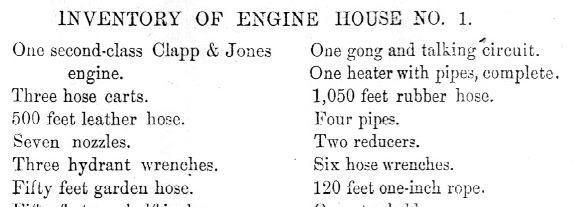 An 1875 Inventory of the Equipment of Engine House No. 1
An 1875 Inventory of the Equipment of Engine House No. 1
Columnist Marie Cochran on the Fire Alarm Operators, from The Toledo News-Bee Sept. 15, 1936.
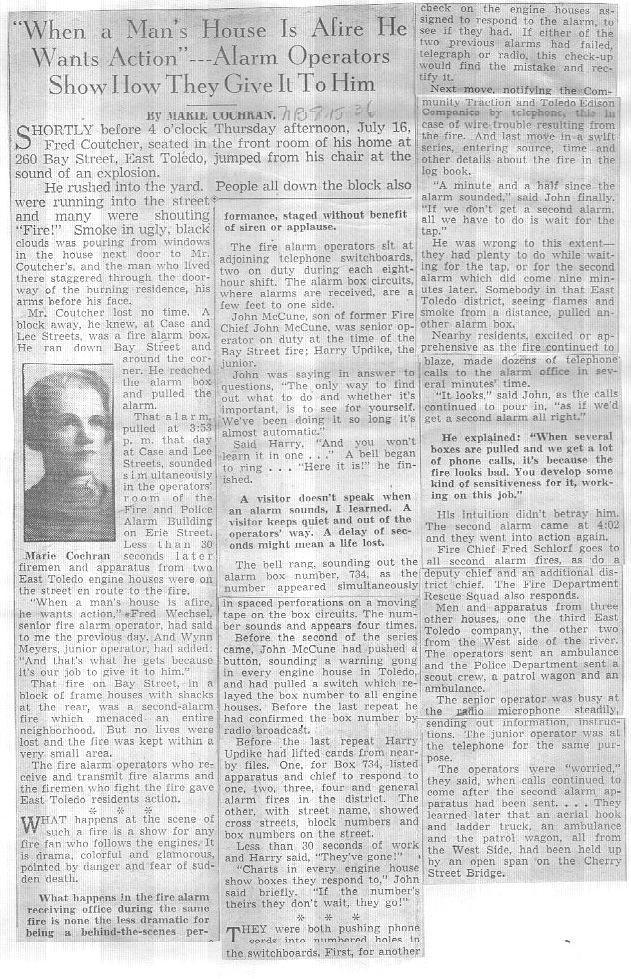 Columnist Marie Cochran on the Fire Alarm Operators, from The News-Bee Sept. 15, 1936.
Columnist Marie Cochran on the Fire Alarm Operators, from The News-Bee Sept. 15, 1936.
A Description of the Alarm System from the Toledo Times, Feb. 26, 1944.
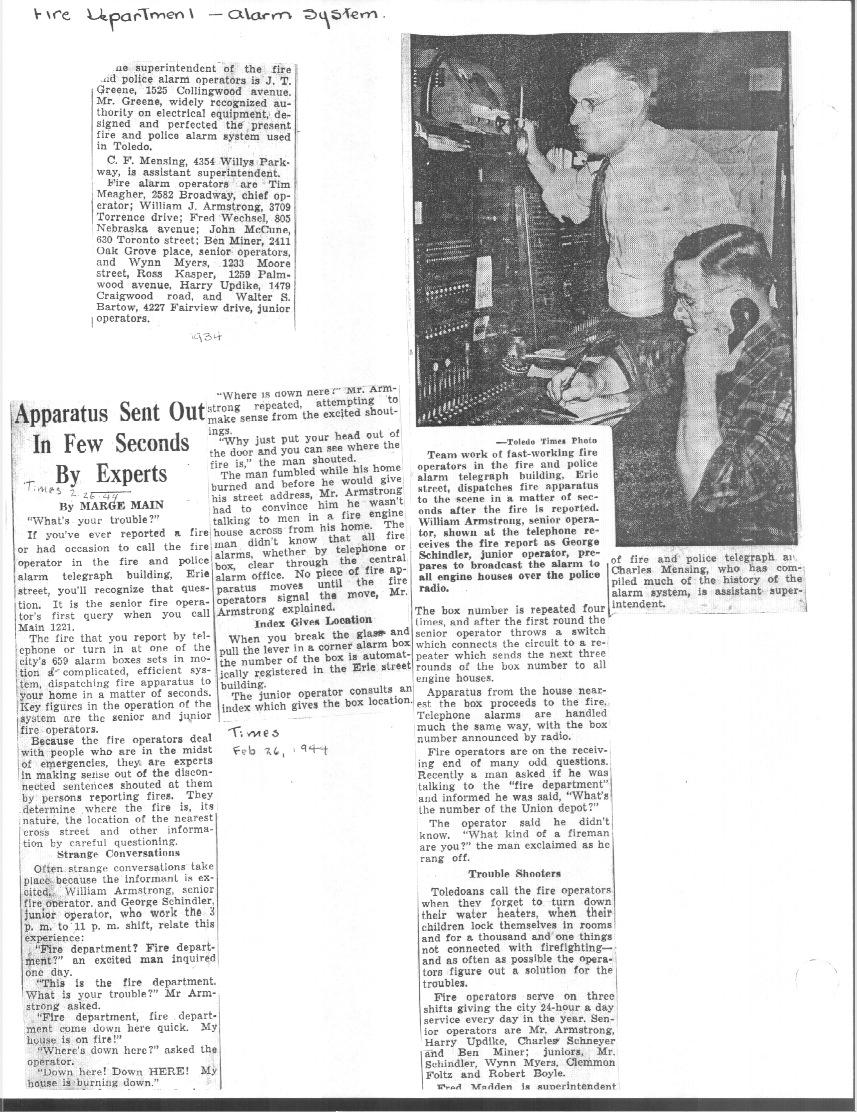 A Description of the Alarm System
A Description of the Alarm System
The Fires
Due to the disparity in size between newspapers and computer screens, only a portion of a news page can be displayed at any one time. The illustration to the left shows how one full page of a newspaper is translated into computer pages. The black rectangles are print columns and the green squares are computer pages. When reading a story, it is neccesary to move from one computer display to another when reading down a column or from the bottom of one column to the top of another
 Scanning Order of Newspaper Clippings
Scanning Order of Newspaper Clippings
Graph of the Historical Change in Fire Frequency as a Ratio of Population, 1867-1976: Toledo Fire Graphs and Data
One of the consequences of industrial development has been a vast increase in the frequency of fires. The figures speak for themselves. As to the causes of this change, a general conclusion can be drawn from a comparison of listed causes of fires from 1885 and 1969:
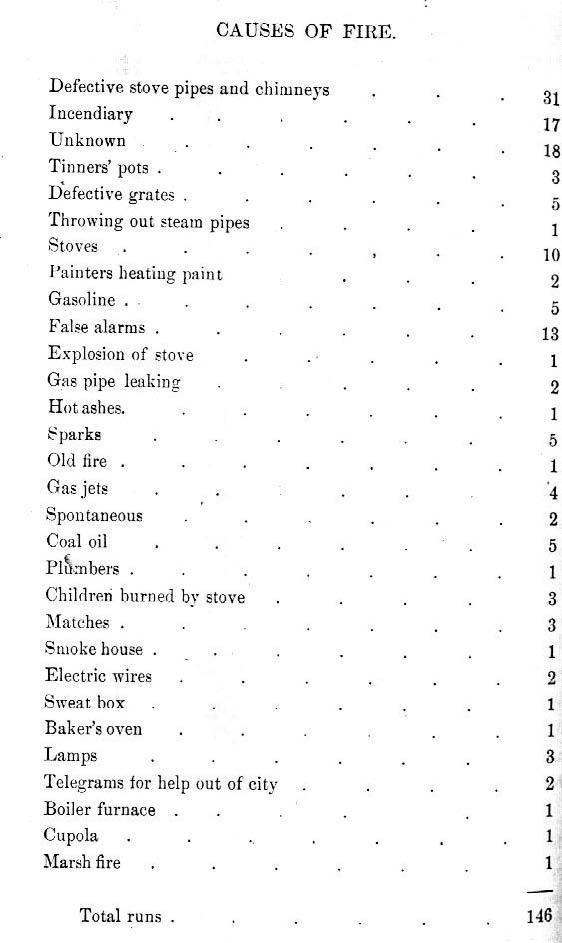 Causes of Fires in Toledo from the Report of the Fire Inspector, 1885.
Causes of Fires in Toledo from the Report of the Fire Inspector, 1885.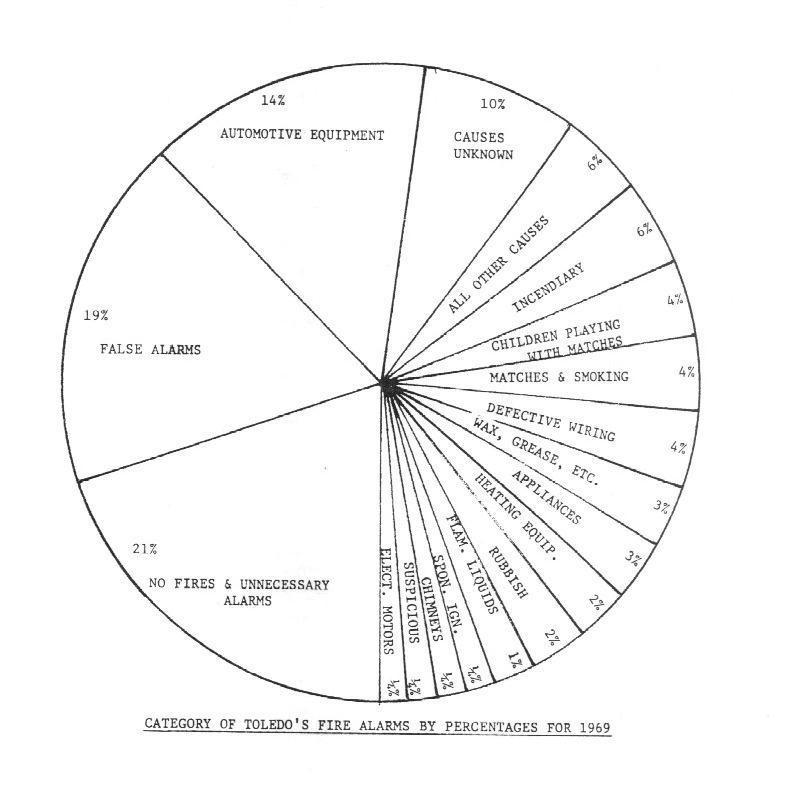 Category of Toledo's Fire Alarms by Percentages for 1969
Category of Toledo's Fire Alarms by Percentages for 1969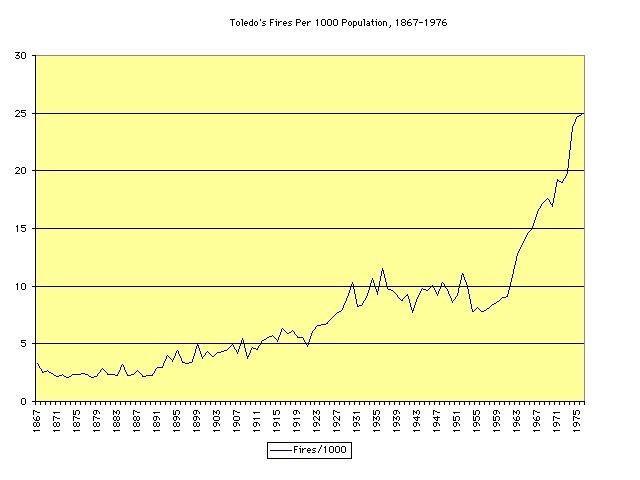 Toledo's Fires per 1,000 population, 1867-1976
Toledo's Fires per 1,000 population, 1867-1976
List of Notable Fires, with Toledo Fire Data Table (1867-1976) and Big Fires (1920-1976)
DATA
[Yearly population figures are extrapolated from the decennial census.]
| Year | # of Fires | City Population | F/P Ratio |
| 1867 | 82 | 24877 | 3.29621739 |
| 1868 | 68 | 27113 | 2.50802198 |
| 1869 | 78 | 29349 | 2.65767147 |
| 1870 | 78 | 31584 | 2.46960486 |
| 1871 | 73 | 33439 | 2.18307964 |
| 1872 | 83 | 35294 | 2.35167451 |
| 1873 | 76 | 37149 | 2.0458155 |
| 1874 | 91 | 39004 | 2.33309404 |
| 1875 | 97 | 40859 | 2.37401796 |
| 1876 | 104 | 42714 | 2.43479889 |
| 1877 | 106 | 44569 | 2.37833472 |
| 1878 | 98 | 46424 | 2.11097708 |
| 1879 | 108 | 48279 | 2.23699745 |
| 1880 | 144 | 50137 | 2.87213036 |
| 1881 | 127 | 53267 | 2.38421537 |
| 1882 | 132 | 56397 | 2.34055003 |
| 1883 | 132 | 59527 | 2.21748114 |
| 1884 | 199 | 62657 | 3.17602183 |
| 1885 | 146 | 65787 | 2.21928345 |
| 1886 | 163 | 68917 | 2.36516389 |
| 1887 | 195 | 72047 | 2.70656655 |
| 1888 | 165 | 75177 | 2.19482022 |
| 1889 | 175 | 78307 | 2.23479382 |
| 1890 | 186 | 81434 | 2.28405826 |
| 1891 | 254 | 86473 | 2.93733304 |
| 1892 | 269 | 91512 | 2.9395052 |
| 1893 | 387 | 96551 | 4.00824435 |
| 1894 | 354 | 101590 | 3.48459494 |
| 1895 | 467 | 106629 | 4.37967157 |
| 1896 | 373 | 111668 | 3.34025862 |
| 1897 | 380 | 116707 | 3.25601721 |
| 1898 | 423 | 121746 | 3.4744468 |
| 1899 | 625 | 126785 | 4.92960524 |
| 1900 | 487 | 131822 | 3.69437575 |
| 1901 | 588 | 135490 | 4.33980368 |
| 1902 | 548 | 139158 | 3.93796979 |
| 1903 | 601 | 142826 | 4.20791733 |
| 1904 | 640 | 146494 | 4.36877961 |
| 1905 | 677 | 150162 | 4.50846419 |
| 1906 | 759 | 153830 | 4.93401807 |
| 1907 | 658 | 157498 | 4.17783083 |
| 1908 | 874 | 161166 | 5.42298003 |
| 1909 | 612 | 164834 | 3.71282624 |
| 1910 | 794 | 168497 | 4.71225007 |
| 1911 | 787 | 175964 | 4.47250574 |
| 1912 | 964 | 183431 | 5.25538213 |
| 1913 | 1054 | 190898 | 5.52127314 |
| 1914 | 1129 | 198365 | 5.69152824 |
| 1915 | 1067 | 205832 | 5.18383925 |
| 1916 | 1345 | 213299 | 6.30570232 |
| 1917 | 1300 | 220766 | 5.88858792 |
| 1918 | 1401 | 228233 | 6.13846376 |
| 1919 | 1304 | 235700 | 5.53245651 |
| 1920 | 1339 | 243164 | 5.5065717 |
| 1921 | 1185 | 247919 | 4.77978695 |
| 1922 | 1515 | 252674 | 5.99586819 |
| 1923 | 1704 | 257429 | 6.61930086 |
| 1924 | 1740 | 262184 | 6.63656058 |
| 1925 | 1800 | 266939 | 6.7431136 |
| 1926 | 1983 | 271694 | 7.29865216 |
| 1927 | 2132 | 276449 | 7.71209156 |
| 1928 | 2235 | 281204 | 7.9479666 |
| 1929 | 2582 | 285959 | 9.02926643 |
| 1930 | 3009 | 290718 | 10.3502363 |
| 1931 | 2383 | 289881 | 8.22061467 |
| 1932 | 2423 | 289044 | 8.38280677 |
| 1933 | 2655 | 288207 | 9.21212878 |
| 1934 | 3071 | 287370 | 10.6865713 |
| 1935 | 2670 | 286533 | 9.31829842 |
| 1936 | 3300 | 285696 | 11.5507392 |
| 1937 | 2795 | 284859 | 9.81187184 |
| 1938 | 2741 | 284022 | 9.65066086 |
| 1939 | 2569 | 283185 | 9.07180818 |
| 1940 | 2484 | 282349 | 8.7976228 |
| 1941 | 2646 | 284476 | 9.30131189 |
| 1942 | 2209 | 286603 | 7.70752574 |
| 1943 | 2585 | 288730 | 8.95300107 |
| 1944 | 2850 | 290857 | 9.79862957 |
| 1945 | 2813 | 292984 | 9.60120689 |
| 1946 | 2977 | 295111 | 10.0877297 |
| 1947 | 2724 | 297238 | 9.16437333 |
| 1948 | 3077 | 299365 | 10.2784227 |
| 1949 | 2896 | 301492 | 9.60556167 |
| 1950 | 2595 | 303616 | 8.5469804 |
| 1951 | 2801 | 305055 | 9.1819508 |
| 1952 | 3408 | 306494 | 11.1193041 |
| 1953 | 3070 | 307933 | 9.9697012 |
| 1954 | 2402 | 309372 | 7.76411569 |
| 1955 | 2542 | 310811 | 8.17860372 |
| 1956 | 2442 | 312250 | 7.82065653 |
| 1957 | 2519 | 313689 | 8.03024652 |
| 1958 | 2650 | 315128 | 8.40928131 |
| 1959 | 2748 | 316567 | 8.68062685 |
| 1960 | 2867 | 318,003 | 9.01563822 |
| 1961 | 2969 | 324,585 | 9.14706471 |
| 1962 | 3576 | 331,167 | 10.7981774 |
| 1963 | 4312 | 337,749 | 12.7668772 |
| 1964 | 4680 | 344,331 | 13.5915732 |
| 1965 | 5080 | 350,913 | 14.4765227 |
| 1966 | 5376 | 357,495 | 15.0379726 |
| 1967 | 5965 | 364,077 | 16.3838968 |
| 1968 | 6351 | 370,659 | 17.1343472 |
| 1969 | 6649 | 377,241 | 17.6253376 |
| 1970 | 6492 | 383818 | 16.9142667 |
| 1971 | 7316 | 380900 | 19.207141 |
| 1972 | 7163 | 377982 | 18.9506379 |
| 1973 | 7402 | 375064 | 19.7352985 |
| 1974 | 8828 | 372146 | 23.7218726 |
| 1975 | 9108 | 369228 | 24.667685 |
| 1976 | 9146 | 366310 | 24.9679233 |
The Big Fires: 1920-1976 (Source: List of Notable Fires, from History of the Toledo Fire Division, 1837-1977)
| NAME | ADDRESS | DATE | SIZE | LOSS |
| [no data available] | 1301 Summit | April 11, 1920 | 2nd Alarm and specials | $106,376 loss |
| Immaculate Conception Church Plus 5 damaged houses | Eastern and Maumee | April 29, 1920 | Second Alarm and specials | Loss undetermined |
| Harter Candy Co. | 114-116 Huron Street | November 18, 1921 | [no data available] | $84,000 loss |
| Del-Mar Apartments | 2354 Monroe Street | December 26, 1922 | Second Alarm and specials | $83,700 loss |
| New York Central Freight House | Monroe Street | February 15, 1923 | [no data available] | $200,000 loss |
| Hettrick Bros. Co. | 1236 Oakwood Ave. | February 20, 1923 | Second Alarm and specials | $168,000 loss |
| Eckhardt Monumental Co. | 3043 Monroe St. | December 20, 1924 | 2nd Alarm | $70,000 loss |
| Sts Peter and Paul Church | 738 5. St. Clair St. | February 7, 1926 | 2nd Alarm | $70,000 loss |
| Mauk Lumber Co. | Elm and George St. | November 22, 1926 | 2nd Alarm and specials | $154,000 loss |
| Congregational Church | Collingwood and Acklin | February 5, 1927 | Caused by a gas explosion rocking the West end, three persons killed instantly - 2nd Alarm and specials | $124,948 loss |
| Northwestern Ohio Savings - Blair Realty | 232 Superior Street | July 23, 1929 | 2nd Alarm and specials | $150,000 loss |
| Toledo Grain and Milling | Harrison and Mill | July 28, 1929 | 2nd Alarm and special call | $191,673 loss |
| Northgate Manor | 711 Locust | April 22, 1930 | [no data available] | $83,000 loss |
| American Railway Express Co. | 211 5. St. Clair St. | May 17, 1930 | 3rd Alarm and specials | $22,395 loss |
| Union Station | Morris and Williams | June 10, 1930 | 2nd Alarm - special for 4 pumpers | $300,000 loss |
| Brown Transportation Co. | 624 Brown Ave. | July 21, 1930 | 2nd Alarm | $52,551 loss |
| Alemite Garage | 524 State Street | October 10, 1930 | 3rd Alarm | $52,000 loss |
| American Wall Paper Co. | 622 Jackson | March 22, 1931 | [no data available] | $59,194 loss |
| National Milling Co. | 2221 Front St. | May 21, 1931 | 3rd Alarm | $332,120 loss |
| Western Auto | 231 Superior | June 28, 1932 | 3rd Alarm | $60,000 loss |
| Temple Theater | 225 St. Clair St. | February 10, 1933 | 3rd Alarm | $112,000 loss |
| Kelsey and Freeman Lumber Company | 1225 Indiana Ave. | May 2, 1937 | 4th Alarm | $118,455 loss |
| First Westminster Presbyterian Church | Orange and Huron | July 15, 1937 | 3rd Alarm | $60,000 loss |
| Holy Rosary Parish | 2545 York St. | January 28, 1938 | 2nd Alarm and specials | $83,000 loss |
| Lanes Cut Rate Clothing & A & P Store | 502 Summit Street | May 5, 1938 | 3rd Alarm and specials - 5 story brick commercial | $130,000 loss |
| Walbridge Park Concessions | Broadway | October 26, 1938 | 3rd Alarm | Loss undetermined |
| Willys Overland Motors Inc. | Central Ave. | September 8, 1938 | 4th Alarm - 14 brick buildings | $94,000 loss |
| Doehler Die Casting Co. | 2100 Smead | July 4, 1939 | 2nd Alarm | $197,824 loss |
| Home Furniture Co. | Jackson and Water | June 2, 1940 | 2nd Alarm and specials | $36,370 loss |
| St. Vincent Hospital | 2213 Cherry St. | July 16, 1940 | 3rd Alarm | Loss undetermined |
| D.J. Marleau Hardware | 3602 N. Detroit | February 8, 1940 | 3rd Alarm | $50,000 loss |
| National Terminal and other buildings | 110 Ottawa | June 6, 1941 | 2nd Alarm and specials | $150,000 loss |
| Tugboat - William A. Whitney | Front Street | September 26, 1942 | Twelve crew members burned | $110,000 loss |
| 2 story frame duplex | 1005-1007 W. Woodruff | February 17, 1943 | 2nd Alarm | Fireman Howard Ripple burned to death in the attic. |
| Michigan Bean Co. | 1310 Elm Street | October 11, 1943 | 2nd Alarm and specials | $190,000 loss |
| Colony Business Block | 2100 W. Central Ave | January 12, 1944 | 3rd Alarm and specials - Fireman James Fakehany lost his life in the basement. Fire started in basement near bowling alleys. | $500,000 loss |
| Fiske Refinery | Oakdale | September 27, 1943 | 2nd Alarm and specials | $350,000 loss |
| Harry’s Auto Store | 444 Summit St at Jackson | January 20, 1944 | 4th Alarm and specials - 5 story accessory building damaged. | $242,740 loss |
| [no data available] | 915 Indiana | January 30, 1945 | Five children of Mrs. Henriette Johnson burned to death. Heating stove exploded. | [no data available] |
| D.J. Marleau Hardware | 3516 N. Detroit | August 4, 1945 | 3rd Alarm | $75,000 loss |
| St. Vincent de Paul | 114 Huron St. | October 15, 1945 | 3rd Alarm and specials | Loss undetermined |
| Goodwill Industries | 627 Huron Street | April 12, 1946 | 3rd Alarm and specials | $100,000 loss |
| Roanoke Hotel and United Moving and Storage Co. | 712 Superior | November 13, 1947 | 3rd Alarm and specials | Loss undetermined |
| Page Dairy Co. | 301 Wade | March 8, 1948 | 27 persons hospitalized and two men died when an ammonia drum was exploded by a welding torch blowing a 20’ by 40’ hole through the wall. | $150,000 loss |
| Commercial Metal Treating Co. | 1608 Tracy | December 5, 1948 | 2nd Alarm and specials | $235,000 loss |
| Loyal Order Moose | 802 Cherry | May 2, 1949 | 3rd Alarm | Loss undetermined |
| 615 Adams | Business block | August 26, 1949 | [no data available] | $67,038 loss |
| Collingwood Presbyterian Church | 2108 Collingwood | January 8, 1950 | 2nd Alarm | $71,000 loss |
| Precter Electric Co. | [no data available] | January 26, 1950 | [no data available] | $100,000 loss |
| Swan Creek Lumber Co. | [no data available] | March 18, 1950 | 3rd Alarm and specials | $350,000 loss |
| Modern Furniture Co. | Summit Street | June 12, 1950 | 3rd Alarm | $158,000 loss |
| St. Paul’s Epicopal Church | 4th and Euclid | March 13, 1951 | 3rd Alarm | Unable to determine |
| Banana Distributing Warehouse | 347 S. Erie St. | April 15, 1951 | 2nd Alarm and Specials | $50,000 loss |
| Spring School | Stickney and Spring | June 5, 1951 | $140,000 loss | 3rd Alarm |
| Ohio Tool Co. | 1730 Norwood | February 1, 1952 | 2nd Alarm and Specials | $220,000 loss |
| Hettrick Manufacturing Co. | 1401 Summit Street | February 12, 1952 | 2nd Alarm | $68,000 loss |
| Lucas County lumber Co. | 2216 Consaul Street | September 1, 1952 | 3rd Alarm and specials | $369,000 loss |
| Buckeye News Co. | 2021 Adams | November 13, 1952 | 3rd Alarm and specials | $165,000 loss |
| O&M Seed | 800 Mill Street - | December 17, 1952 | 3rd Alarm and specials | $116,000 loss |
| Recreation Bowling Alleys | 929 Phillips | January 8, 1953 | 3rd Alarm | Loss undetermined |
| Moore Ford Sales Co. | 2929 Monroe Street | November 10, 1955 | 2nd Alarm and specials | $200,000 loss |
| Horn Hardware | 1222 Broadway | January 2, 1956 | 2nd Alarm and 4 specials | $125,000 loss |
| Hy-Grade Meat Co. | 21 Superior Street | February 13, 1956 | 2nd Alarm - An explosion leveled buildings at 17, 19,15,13,23, and 25 Superior Street. 3 men killed | No fire loss |
| Olimphia Bowling Alley | - - | March 29, 1956 | 2nd Alarm | $300,000 loss |
| Leader Department Store | 1025 Sylvania Ave. | January 25, 1958 | 3rd Alarm and specials | $106,000 loss |
| Feaks Restaurant | 235 Superior | April 5, 1958 | 2nd Alarm and 2 specials | $141,000 loss |
| South Side Lumber Co. | 1307 Prouty Ave. | September 7, 1958 | 2nd and Specials | $107,000 loss |
| Epworth Methodist Church | 545 W. Delaware | September 7, 1958 | 3rd and specials | $268,353 loss |
| S. S. Distributers | 1100 W. Central | September 20, 1958 | 3rd and specials - Ken Williams killed | $158,000 loss |
| Continental Grain Co. | 2404 Summit Street | May 16, 1959 | 2nd Alarm and 3 specials | $187,000 loss |
| Bendix Steel Drum | 1044 Hanson St. | August 3, 1959 | 2nd and 3 specials | $352,164 loss |
| Lagrange Builder Supply | 29 Lucas Street | January 26, 1961 | 2nd Alarm and specials | $250,000 loss |
| St. Clair School | 631 St. Clair | July 8, 1961 | 3rd Alarm and specials | $51,000 loss |
| Wachter Shoe Co. | 428 Summit St. | January 28, 1961 | 3rd Alarm | $80,000 loss |
| Anthony Wayne Trail Fire- Gasoline Truck | Vinton and A.W.T. | June 10, 1961 | 4 firemen killed - 3rd Alarm | $50,000 loss |
| Maumee Chemical Co. | # 2 Oak | May 10, 1962 | 3rd Alarm - 12 Civilians killed | $772,000 los |
| Toledo Sports Center | 1516 Starr | February 9, 1963 | 2nd Alarm and 4 specials | $500,000 loss |
| Overmeyer Warehouse and others | 2131 Smead | June 23, 1964 | 4th Alarm and specials | $375,000 loss |
| W. T. Grant Co. | 3010 Monroe Street | April 7, 1964 | 3rd Alarm and specials | $410,000 loss |
| Norfolk and Western R. R. Shops | Fremont and Creston | January 1, 1966 | 2nd Alarm and 5 specials | $100,000 loss |
| Heating Trades Bldg. | 1714 N. 12th Street | May 28, 1966 | 3rd Alarm and 3 specials | $381,000 loss |
| Foodtown Super Market | 3911 Secor | January 17, 1967 | 2nd Alarm and specials | $259,000 loss |
| American Door and Sash Co. | 901 Hoag | September 12, 1967 | 3rd Alarm and 1 special | $147,000 loss |
| BohI Equipment Co. | 1020 Laskey Road | December 5, 1967 | 3rd Alarm | $229,000 loss |
| Westgate Shopping Center | 3301 W. Central | May 9, 1968 | 3rd Alarm | $765,845 loss |
| Cricket West Shopping Center | 3151 W. Central | December 5, 1970 | 3rd Alarm | $400,000 loss |
| Holly-House Apartments | 410 Alexis - | April 1, 1971 | 2nd Alarm and 2 specials | $229,506.96 loss |
| Joseph’s Super Market | 2460 Cherry Street | July 9, 1971 | 2nd and 1 special | $348,414.39 loss |
| Elm Storage | 2631 Harleau | February 18, 1972 | 3rd Alarm and 5 specials | $543,391.00 loss |
| Hagerty Bowling Lanes | 1121 Jackson | June 12, 1972 | 3rd Alarm and specials | $646,500 loss |
| Port Lawrence Bldg. | 206 Michigan | June 14, 1972 | 2nd Alarm and specials | $301,000 loss |
| Vroman Foods Inc. | 4117 Fitch | July 4, 1972 | 2nd Alarm | $342,000 loss |
| Vinlast Corporation | 2077-2135 Smead | May 14, 1973 | 3rd Alarm and 4 specials | $1,280,000 loss |
| Mancy Restaurant | 937 Phillips | August 14, 1973 | 2nd Alarm and 4 specials | $500,000 loss |
| Interlake Steel Co. | 2401 Front | December 23, 1974 | 2 dead and 10 injured | $900,000 loss |
| Paul Minor Floral Supply | 1301-09 W. Bancroft | April 7, 1974 | 2nd Alarm | $204,859 loss |
| Starr Lumber Co. | 1701-15 Starr - | October 23, 1974 | 3rd Alarm and specials | $117,340 loss |
| Same fire - Nordman Roofing Co. | [no data available] | [no data available] | [no data available] | $39,673 loss |
| Kent Branch Library | 3026 Collingwood | December 1, 1974 | 3rd Alarm and specials | $548,484 loss |
| Apex Bolt and Machine Co. | 1007 Front | April 24, 1975 | 2nd Alarm and specials | $103,100 loss |
| Sacred Heart Church | 509 Oswald | May 18, 1975 | 2nd Alarm and specials | $350,000 loss |
| Wayne Lumber Co. | 202 Canal | June 18, 1975 | 3rd Alarm | $220,000 loss |
| Barrett Shoe Company/ Main Restaurant | 133-35 Main Street | June 26, 1975 | 2nd Alarm and specials | $155,200 loss |
| Bismac International, Inc. | 1011 Utica | September 4, 1975 | 3rd Alarm | $417,000 loss |
| Lucas County Lumber Co. | 2216 Counsaul St. | June 9, 1976 | 3rd Alarm and specials | $265,000 loss |
News clippings about historic fires
Toledo Fire Department's Most Tragic Day: The Anthony Wayne Trail Fire [PDF]
The Blade's coverage of the disaster [Google News Archive link]

Elevator Fire Disaster Rocked City 50 Years Ago - - The Union Railroad and Transportation Co. Fire (Source: Blade, Sept. 20, 1898)
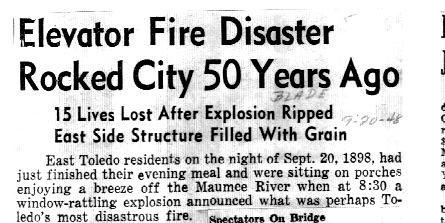 Elevator Fire Disaster Rocked City 50 Years Ago
Elevator Fire Disaster Rocked City 50 Years Ago
Fire and Death - The Dow & Snell Fire (May 20, 1898)
 May 20, 1898 - The Dow & Snell Fire
May 20, 1898 - The Dow & Snell Fire
Dramatic Rescue in fire 51 Years Ago is Recalled -An Account of the Dramatic Rescue at The Dow & Snell Fire (Blade, May 20, 1949)
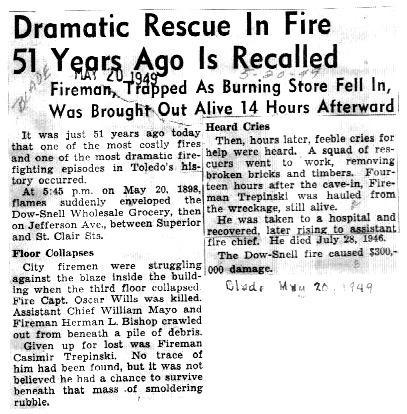 Dramatic Rescue in Fire 51 Years Ago is Recalled
Dramatic Rescue in Fire 51 Years Ago is Recalled
Flame Swept Toledo: Nearly a Million Dollars Went Up in Smoke Last Night - - The Chamber of Commerce Fire (January 3, 1894) [Article link]
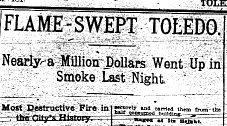 January 3, 1894 - The Chamber of Commerce Fire
January 3, 1894 - The Chamber of Commerce Fire
Rosen's Junk Warehouse Fire - Capt. Gallacher Lost His Life Fighting the Fire Fiend [Article link]
Warren & Bidwell Co. Fire 1872 - A Thief in the Night [Article Link]
December 11, 1916 - Tragedy at the Paddock Merchandising Fire from History of the Toledo Fire Division, 1837-1977
December 11, 1916 will long be remembered in the annals of Toledo’s serious fire tragedies.
Captain Edward Welch and Driver Al Urie of no 6 firehouse were killed at 9 a.m. Monday when a section of the roof and stock from two floors of the paddock merchandising company collapsed and buried them under tons of debris in the basement. .
Pratt was caught by timbers at the edge of the first floor. His cries were heard as soon as the noise of the cave-in subsided. He told firemen he was pinned between the first floor and a pile of debris and timbers and that a heavy ten inch spike was penetrating his back in the area of his kidney.
He begged firemen to dig for the other two because he was conscious and could stick it out. Firemen worked an hour before they uncovered his head and soon had him free of debris to his ankles where they discovered his feet were caught in twisted steel rods.
City workers from all divisions came to help. Someone offered Pratt whiskey, but he refused, taking only cold water. His body was becoming wet and cold. Dr. G. T. Hannah and Dr. L. W. Briggs gave him a hypodermic and directed men to fill empty beer bottles with warm water to line his body for warmth and a Rail Lite employee attached 200 feet of electric line to rig a warming pan for his back. This all contributed greatly to reducing shock and preserving his life while they tried to free him.
Another Rail Lite employee, Tom Martin secured cable cutters and cut the spike off at Pratt’s back, while another brought an acetylene torch to cut the metal from his ankles.
After five hours of grueling work by rescuers and severe pain of Hoseman Pratt, he was taken to St. Vincent’s hospital where he was in serious condition.
Monsignor J. T. O’Connell and Rev. George A. Brannigan, pastor of Good Shepherd Church, climbed down ladders and administered last rites for Captain Welch and Driver Urie after making sure Hoseman Pratt was attended to.
Watching anxiously and scanning each face of the rescue workers as they came from the basement was the wife of Al IUrie. When no familiar face appeared, she resumed her quiet sobbing thinking of her five fatherless children at home.
Neighbors at the Pratt home were trying to console Mrs. Pratt and her two children and trying to restrain her from coming to the scene.
Mrs. Welch went to St. Vincent’s and then to fire headquarters where she bravely held aback her grief. Her husband had only one year to serve before being pensioned. She knew she had to return home and share her sadness with her six children.
Chief Pelling said damage was estimated at more than $100,000 to building and stock which consisted mostly of wrapping paper, burlap, baskets, woodenware, and package merchandising.
Toledo's Fire Fighters
Memorial List of Toledo Firefighters Killed in the Line of Duty, 1872-1976
St. Florian, heaven's patron of firefighters, who once was dedicated to the services of your fellowmen as an official in the army of Rome, look with kindly and professional eye upon your earthly force, desirous of the preserving of our fellowmen from the dangers to life and property.
Give us cool heads, stout hearts, strong muscles, an instinct for prudent investigation and wise judgment.
Make us the terror of arsonists, the friends of children and law-abiding citizens, kind to the frightened, polite to the bores, strict with lawbreakers, and obstinate to temptations.
In troubles give us strength to be efficient, in times of great danger, give us the ability to be calm and enable us to impart assurance to those who verge on panic.
You know, beloved St. Florian, from the sacrifice of your own life for the sake of your faith, that the fireman's lot on earth is not always a pleasant one, but your own sense of duty that so pleased God, your courageous strength that so over-whelmed the devil and your saintly self-control, give us inspiration.
Make us fearless in practicing the laws of God as we are brave in protecting the lives and property of our fellowmen, and when we answer our final alarm, enroll us in your heavenly force, where we will be as proud to protect the throne of God as we have been to protect the city.
-A Firefighter's Prayer
Ewald E. Bode, July 28, 1961, Deputy Chief, Died as a result of burns received at explosion of gasoline truck at Anthony Wayne Trail and Vinton Street on June 10, 1961.
Glenn E. Carter, June 23, 1961, Badge 246, Died as a result of burns received at explosion of gasoline truck at Anthony Wayne Trail and Vinton Street on June 10, 1961.
Richard Donnelly, December 11, 1902
Died from injuries received at the Keifer Bros. Furniture, Dorr Street, Fire Box 171.
George J. Ehmann, October 29, 1937, District Chief Killed in collision at Lincoln and Lawrence Avenues, responding to a fire at Libbey High School.
Andrew J. Flynn, January 31, 1932, Captain Died of injuries received when # 16 ladder was involved in accident with Community Traction Bus.
James P. Fakehany, January 12, 1944
Fell through floor at fire at Colony Block and burned to death.
James Fraser, January 3, 1894
Burned to death at King Elevator fire, body never found.
Louis W. Fuhr, March 22, 1969, Badge 427
Killed while responding to false alarm when #18 Pumper struck by automobile at Jackman and Laskey Road.
John M. Gallagher, September 19, 1900, Captain Killed at a fire at Henry Rosen’s Junk Warehouse, corner of Vance and 13th St.
William G. Genson, July 10, 1961, Badge 435, Died as a result of burns received at explosion of gasoline truck at Anthony Wayne Trail and Vinton Street on June 10, 1961.
Robert G. Harrison, June 15, 1961, Badge 290, Died as a result of burns received at explosion of gasoline truck at Anthony Wayne Trail and Vinton Street on June 10, 1961.
John B. Kaintz, February 25, 1915
Died of injuries received at # 5 Fire Station while answering an alarm to the Wabash Railroad
Roundhouse.
Bernard A. Orzechowski, January 31, 1932 Badge 55 - Died of injuries received when # 16 ladder was involved in accident with Community Traction Bus.
Paul J. Quigley, February 14, 1931
Badge 130 - Killed at # 18’s when he fell during ladder drill.
Robert J. Pietras, June 21, 1969
Captain, Died from injuries received fighting a fire at 2472 Lawton, Box 1151 on June 10, 1969.
Edward Radunz, June 21, 1932
Died of injuries from fall at Willys Parkway and Berdan.
Howard C. Rippel, February 17, 1948
Burned to death at fire at 1005 W. Woodruff Ave., Box
Chester A. Rybarczyk, September 2, 1967
Lieutenant, killed at 2nd Alarm, Box 1462, PeeWee's Bar, 5101 Suder Ave.
Thomas J. Smith, December 9,1902
Killed by falling walls at Keifer Bros. Furniture Store -
Dorr Street.
Emil M. Steck, Jr., November 16, 1947 Died of injuries received in accident Nov. 13, 1947 involving # I pumper.
John C. Timmers, April 20, 1916
Badge 161 - Died from injuries received when # 2’s
steamer ran over him at corner of Erie & Adams
Streets, while responding to Box 34.
Albert T. Urie, December 11, 1916
Killed at the Paddock Merchandise Company Fire - 114
St. Clair Street.
John Viebrook, July 31, 1883
Fell from the top of the hose drying tower after returning from a fire.
John B. Ward, December 24, 1901, Captain
Box 153, Nebraska & Hawley St. False Alarm, Captain
Ward was killed when #7 H & L collided with Oak Street
car at Collingwood & Dorr St.
Edward J. Welch, December 11, 1916, Captain
Killed at the Paddock Merchandise Company Fire - 114
St. Clair Street
James Welch, December 15, 1872
Was killed when he fell from a ladder passing hose at a
fire at Ottawa and Lafayette.
Vanner E. Wendt, December 25, 1933
Badge 192 - Died of injuries received at fire’on Suder
Ave., was hit in the neck by nozzle.
Ralph H. Westfall, January 30, 1902
Died of injuries received at Henry Rosen’s Junk
Warehouse Fire.
Kenneth L. Williams, September 20, 1958
Badge 16, Killed at fire at 1100 W. Central Avenue.
Oscar S. Wills, May 22, 1898, Captain
Was killed by falling walls at Dow & Snell Wholesale
Grocery at Superior & Jefferson.
David D. Young, October 24, 1901
Died of injuries sustained when he fell through the pole hole at # 13’s Engine House.
Killed in Military Service During World War Two
George Lutife
Louis M. Ziebar
Raymond A. Romeos
Eugene McHugh
Ralph L. Wiesenberg
Nicholas Seybold
Volunteer Firemen in Toledo's Early Days (From the Blade)
A Profile of the Fire Alarm Operators (circa 1930s)
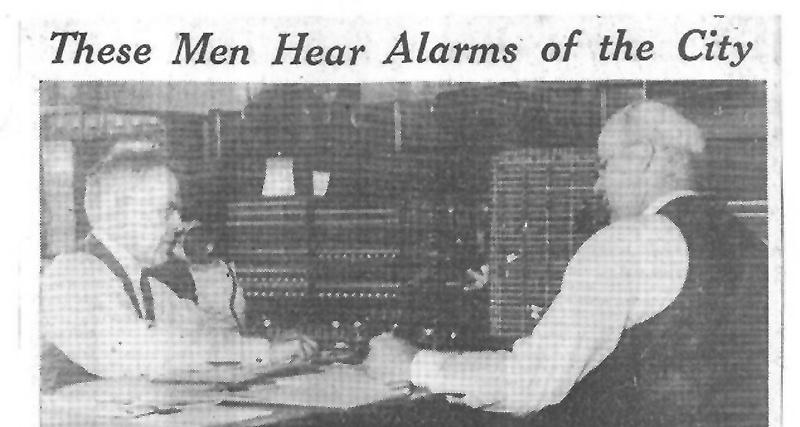 These Men Hear Alarms of the City: Alert Operators Responsible for Speed of Fire Department
These Men Hear Alarms of the City: Alert Operators Responsible for Speed of Fire Department
A Few Fire Chiefs Remembered:
Division Chief Louis H. Elling 1915-1927
Capt. David Manley - Firefighter 1890-1916 and Inventor of Firefighting Helmet
Division Chief Fred T. Schlorf 1935-1946 (PDF, 3 p.)
Richard Lawler - Firefighter and District Chief 1881-1935
Charles (Scotty) Schneyer - Chief Fire Alarm Operator
Casimir Trepinski - Firefighter and Assistant Chief 1893-1935
Earl Walterschied - Firefighter and Chief Inspector 1920-1949
Joseph W. McLaughlin Firefighter and Deputy Chief 1907-1949
Joseph Kenney - Firefighter and District Fire Chief 1907-1950
Division Chief Karl B. Scheidler 1951-1952
Clarence Blanchard - District Chief and Head of Fire Prevention Bureau
Frank A. Lichtenwagner - Firefighter and District Chief 1920-1968
William H. Young- Firefighter and District Chief 1929-1968*
*There was no link to an article on William H. Young
Profiles of the Fallen Firefighters:
The Firefighter's Memorial [Article Link]
The Equipment
"Bertha" - The water-tower truck of the early 20th century
The Discontinuation of the Ages-Old Gong System of Station Alarms, from the Blade, Jan. 21, 1952.
The First Fire Engine Used in Toledo
The Toledo-Built Schacht Pumper (PDF, 2 p.)
The Toledo-Built Schacht Aerial Truck
The fire tug controversy of 1908
The Toledo Fire Fighters Museum (Photo Gallery)
